Paul van Yperen's Blog, page 236
April 30, 2019
Das Dreimäderlhaus (1918)
The German silent film Das Dreimäderlhaus/The House of Three Girls (Richard Oswald, 1918) tells with about a love affair of the young composer Franz Schubert in Vienna in 1826 and his attempts to assert himself as a composer. Das Dreimäderlhaus was based on a homonymous operetta, first performed in 1916 and using Schubert's music. The film is now considered as lost.
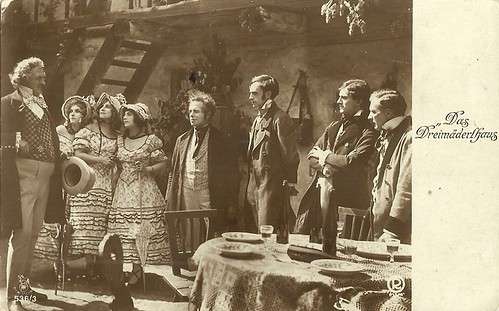
German postcard by Rotophot in the Film Sterne series, no. 536/3. Photo: Richard-Oswald-Film. Publicity still for Das Dreimäderlhaus/The House of Three Girls (Richard Oswald, 1918), with Julius Spielmann as Franz Schubert. Right of Spielmann stands Conrad Veidt , who plays Baron Schober, while the tall, sturdy man on the left may be Wilhelm Diegelmann (Tschöll). The three daughters are played by Sybile Binder, Käthe Oswald, and Ruth Werner.
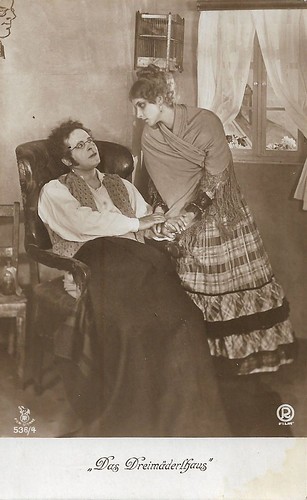
German postcard by Rotophot in the Film Sterne series, no. 536/4. Photo: Richard-Oswald-Film. Publicity still for Das Dreimäderlhaus/The House of Three Girls (Richard Oswald, 1918), with Julius Spielmann as Franz Schubert. The woman could be Sybille Binder, who plays Schubert's love interest Hannerl.
Three love affairs and a misunderstanding
Das Dreimäderlhaus/The House of Three Girls (Richard Oswald, 1918) was based on a homonymous operetta, first performed in 1916 and using Franz Schubert's music. Successful English-language operetta adaptations were made such as 'Chanson d'amour' (1921), 'Blossom Time' (1921) and 'Lilac Time' (1922)
The story deals with the love affairs of the three daughters of court glassmaker Christian Tschöll with Franz Schubert (Julius Spielmann) and two of his friends. One of them is the painter Moritz von Schwind (Eynor Ingesson).
Under the lilac tree Tschöll (Wilhelm Diegelmann) agrees to the marriage of his three daughters with the three young men, but while Schubert's friends marry, a misunderstanding prevents marriage between Schubert and Hannerl (Sybille Binder).
Schubert's circle of friends includes also the young Baron Franz von Schober ( Conrad Veidt ), against whose maneuvers his girlfriend Grisi ( Anita Berber ) warns Hannerl. Hannerl instead thinks Grisi warns her against Schubert, so she marries Schober instead, and Schubert is left alone.
In 1958, a new film version was made, Das Dreimäderlhaus (Ernst Marischka, 1958) with Karlheinz Böhm as Franz Schubert
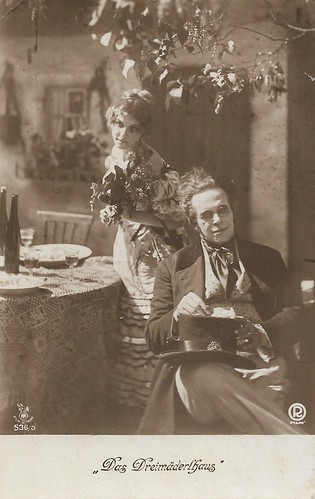
German postcard by Rotophot in the Film Sterne series, no. 536/5. Photo: Richard-Oswald-Film. Publicity still for Das Dreimäderlhaus/The House of Three Girls (Richard Oswald, 1918), with Julius Spielmann as Franz Schubert (the man with spectacles here) and behind him, Sybile Binder as Hannerl.
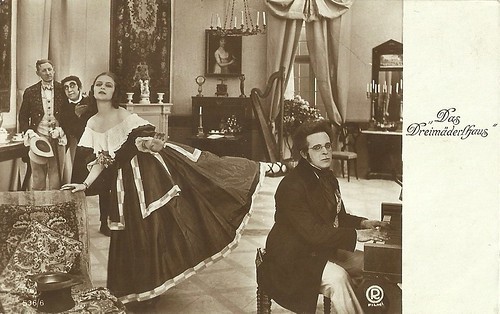
German postcard by Rotophot in the Film Sterne series, no. 536/5. Photo: Richard-Oswald-Film. Publicity still for Das Dreimäderlhaus/The House of Three Girls (Richard Oswald, 1918), with Anita Berber and Julius Spielmann.
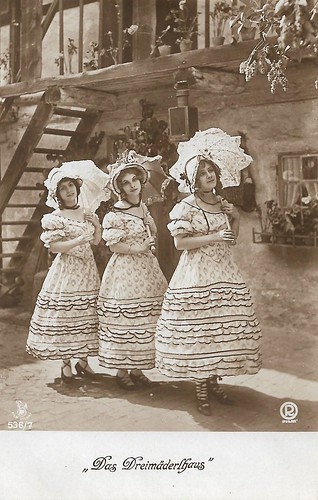
German postcard by Rotophot in the Film Sterne series, no. 536/7. Photo: Richard-Oswald-Film. Publicity still for Das Dreimäderlhaus/The House of Three Girls (Richard Oswald, 1918). The three sisters from the title, presented here, are played by Sybille Binder, Käthe Oswald, and Ruth Werner.
Sources: IMDb

German postcard by Rotophot in the Film Sterne series, no. 536/3. Photo: Richard-Oswald-Film. Publicity still for Das Dreimäderlhaus/The House of Three Girls (Richard Oswald, 1918), with Julius Spielmann as Franz Schubert. Right of Spielmann stands Conrad Veidt , who plays Baron Schober, while the tall, sturdy man on the left may be Wilhelm Diegelmann (Tschöll). The three daughters are played by Sybile Binder, Käthe Oswald, and Ruth Werner.

German postcard by Rotophot in the Film Sterne series, no. 536/4. Photo: Richard-Oswald-Film. Publicity still for Das Dreimäderlhaus/The House of Three Girls (Richard Oswald, 1918), with Julius Spielmann as Franz Schubert. The woman could be Sybille Binder, who plays Schubert's love interest Hannerl.
Three love affairs and a misunderstanding
Das Dreimäderlhaus/The House of Three Girls (Richard Oswald, 1918) was based on a homonymous operetta, first performed in 1916 and using Franz Schubert's music. Successful English-language operetta adaptations were made such as 'Chanson d'amour' (1921), 'Blossom Time' (1921) and 'Lilac Time' (1922)
The story deals with the love affairs of the three daughters of court glassmaker Christian Tschöll with Franz Schubert (Julius Spielmann) and two of his friends. One of them is the painter Moritz von Schwind (Eynor Ingesson).
Under the lilac tree Tschöll (Wilhelm Diegelmann) agrees to the marriage of his three daughters with the three young men, but while Schubert's friends marry, a misunderstanding prevents marriage between Schubert and Hannerl (Sybille Binder).
Schubert's circle of friends includes also the young Baron Franz von Schober ( Conrad Veidt ), against whose maneuvers his girlfriend Grisi ( Anita Berber ) warns Hannerl. Hannerl instead thinks Grisi warns her against Schubert, so she marries Schober instead, and Schubert is left alone.
In 1958, a new film version was made, Das Dreimäderlhaus (Ernst Marischka, 1958) with Karlheinz Böhm as Franz Schubert

German postcard by Rotophot in the Film Sterne series, no. 536/5. Photo: Richard-Oswald-Film. Publicity still for Das Dreimäderlhaus/The House of Three Girls (Richard Oswald, 1918), with Julius Spielmann as Franz Schubert (the man with spectacles here) and behind him, Sybile Binder as Hannerl.

German postcard by Rotophot in the Film Sterne series, no. 536/5. Photo: Richard-Oswald-Film. Publicity still for Das Dreimäderlhaus/The House of Three Girls (Richard Oswald, 1918), with Anita Berber and Julius Spielmann.

German postcard by Rotophot in the Film Sterne series, no. 536/7. Photo: Richard-Oswald-Film. Publicity still for Das Dreimäderlhaus/The House of Three Girls (Richard Oswald, 1918). The three sisters from the title, presented here, are played by Sybille Binder, Käthe Oswald, and Ruth Werner.
Sources: IMDb
Published on April 30, 2019 22:00
April 29, 2019
Thomas Graals bästa film (1917)
The Swedish silent comedy Thomas Graals bästa film/Thomas Graal's Best Film (Mauritz Stiller, 1917), scripted by Gustav Molander (as Harald B. Harald), deals with a screenwriter who falls in love with his secretary Bessie and imagines himself rescuing her from poverty. Reality is quite different as Bessie is a modern woman. The film also mocks the bored aristocracy involved in the modernity of filmmaking. Victor Sjöström and Karin Molander starred in this delicious little gem.

Swedish postcard by Ed. Nordisk Konst, Stockholm, no. 876/1. Photo: Svenska Biografteatern AB. Publicity still for Thomas Graals bästa film/Thomas Graal's Best Film (Mauritz Stiller, 1917). Caption: The home she ran away from, as it was described. Karin Molander as Bessie, with her parents played by Albin Lavén and Jenny Tschernichin-Larsson.

Swedish postcard by Ed. Nordisk Konst, Stockholm, no. 876/3. Photo: Svenska Biografteatern AB. Publicity still for Thomas Graals bästa film/Thomas Graal's Best Film (Mauritz Stiller, 1917) with Victor Sjöström . Caption: The author Thomas Graal at sea.
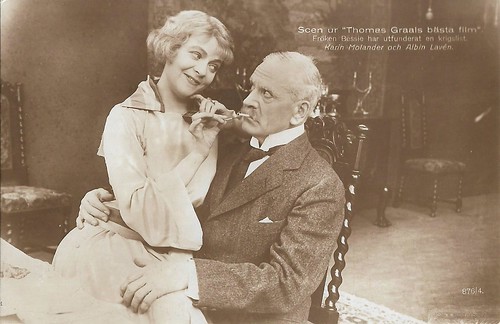
Swedish postcard by Ed. Nordisk Konst, Stockholm, no. 876/4. Photo: Svenska Biografteatern AB. Publicity still for Thomas Graals bästa film/Thomas Graal's Best Film (Mauritz Stiller, 1917), with Karin Molander as Bessie and Albin Lavén, who plays her father. Caption: Miss Bessie has invented a war stratagem.
An adorable romantic comedy, a social tract and one of the first films about filmmaking
In Thomas Graals bästa film/Thomas Graal's Best Film (Mauritz Stiller, 1917), the great Victor Sjöstrom stars as Thomas Graal, a screenwriter. He is very fond of his secretary Bessie, played by the lovely Karin Molander . However, she runs away from his kisses and embraces. In fact, Bessie has already run away earlier from her proper and domineering mother and her bumbling father to go to the big city, where she claimed to Thomas Graal that her parents are poor and mistreat just to get her a job as his secretary.
After she has run away from Thomas' kisses and embraces, Bessie is forced by family servants to go back to her parent's home. In his misfortune, Thomas Graal has run out of ideas. He embroiders Bessie's tall tales to create a screenplay and insists that Bessie must be found to play the leads with him in order to meet her again.
At IMDb , The Red Dutchess writes: "'Thomas Graal's Best Film' is one of the best comedies of the silent era. It works as an adorable romantic comedy about a concupiscent novelist who falls for his secretary; as a startling social tract, with the dessicated aristocracy giving onto the modern world of cinema, entrepreneurs and the New Woman; as one of the first films about filmmaking - there is an exquisite parody of Griffith's monumental 'Intolerance', as the actor playing a hanged criminal complains about the pain of being hoist from a ceiling."
"Stiller's movie shows a thrilling modernity in this sequence as it blurs not only the reality of Graal's writing and the fantasy he imagines, but also intrudes Bessie's own story: she disrupts his narrative just as she disrupts all the forces of (male) power that would try to pin her down. Bessie is one of the great heroines of silent film, permanently amused by the absurd complacency of the inferiors surrounding her, with a gorgeous, generous grin suggesting both a taste for playfulness, and a voracious sexual appetite. The scene where she flees her father and ritualistically forces him to abandon his paternalistic intentions by destroying the bridge between them is hilarious but provocative."
Thomas Graals bästa film/Thomas Graal's Best Film (Mauritz Stiller, 1917) was shot at Svenska Biografteatern's studio at Lidingö with exteriors filmed by Henrik Jaenzon at Restaurant Blå Portens garden at Djurgården and various places in Stockholm.
Thomas Graals bästa film/Thomas Graal's Best Film was premiered on 13 August 1917 at the cinema Röda Kvarn in Stockholm. A year later, the film got a sequel, Thomas Graals bästa barn/Thomas Graal's best child (Mauritz Stiller, 1918) with mostly the same cast and crew.
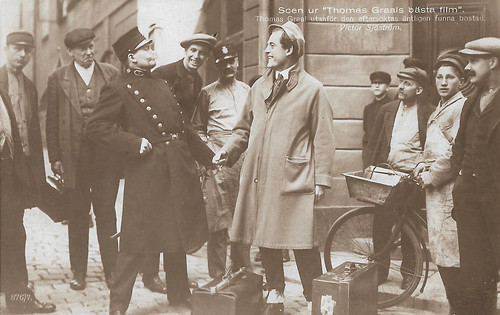
Swedish postcard by Ed. Nordisk Konst, Stockholm, no. 876/7. Photo: Svenska Biografteatern AB. Publicity still for Thomas Graals bästa film/Thomas Graal's Best Film (Mauritz Stiller, 1917), with Victor Sjöstrom . Caption: Thomas is found outside of the end-of-life home.
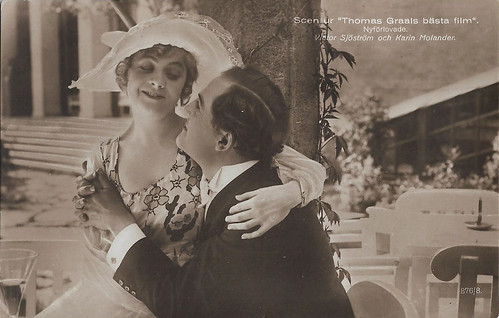
Swedish postcard by Ed. Nordisk Konst, Stockholm, no. 876/8. Photo: Svenska Biografteatern AB. Publicity still for Thomas Graals bästa film/Thomas Graal's Best Film (Mauritz Stiller, 1917), with Victor Sjöström and Karin Molander . Caption: The newly engaged ones.
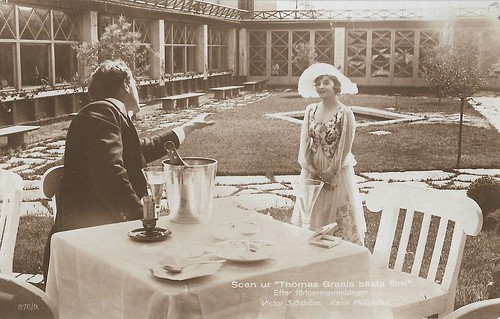
Swedish postcard by Ed. Nordisk Konst, Stockholm, no. 876/9. Photo: Svenska Biografteatern AB. Publicity still for Thomas Graals bästa film/Thomas Graal's Best Film (Mauritz Stiller, 1917), with Victor Sjöström and Karin Molander . Caption: After the engagement dinner.
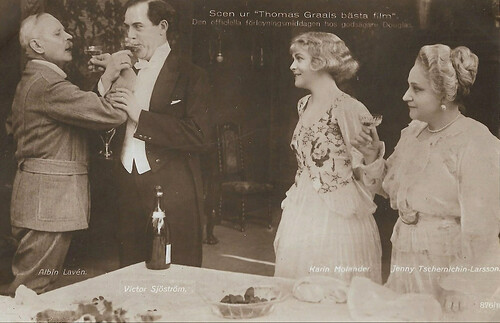
Swedish postcard by Ed. Nordisk Konst, Stockholm, no. 876/10. Photo: Svenska Biografteatern AB. Publicity still for Thomas Graals bästa film/Thomas Graal's Best Film (Mauritz Stiller, 1917). Caption: The official engagement dinner with landlord Douglas and his wife, Bessie's parents (played by Albin Lavén and Jenny Tschernichin-Larsson).
Sources: The Red Dutchess (IMDb), Wikipedia (Swedish) and IMDb.

Swedish postcard by Ed. Nordisk Konst, Stockholm, no. 876/1. Photo: Svenska Biografteatern AB. Publicity still for Thomas Graals bästa film/Thomas Graal's Best Film (Mauritz Stiller, 1917). Caption: The home she ran away from, as it was described. Karin Molander as Bessie, with her parents played by Albin Lavén and Jenny Tschernichin-Larsson.

Swedish postcard by Ed. Nordisk Konst, Stockholm, no. 876/3. Photo: Svenska Biografteatern AB. Publicity still for Thomas Graals bästa film/Thomas Graal's Best Film (Mauritz Stiller, 1917) with Victor Sjöström . Caption: The author Thomas Graal at sea.

Swedish postcard by Ed. Nordisk Konst, Stockholm, no. 876/4. Photo: Svenska Biografteatern AB. Publicity still for Thomas Graals bästa film/Thomas Graal's Best Film (Mauritz Stiller, 1917), with Karin Molander as Bessie and Albin Lavén, who plays her father. Caption: Miss Bessie has invented a war stratagem.
An adorable romantic comedy, a social tract and one of the first films about filmmaking
In Thomas Graals bästa film/Thomas Graal's Best Film (Mauritz Stiller, 1917), the great Victor Sjöstrom stars as Thomas Graal, a screenwriter. He is very fond of his secretary Bessie, played by the lovely Karin Molander . However, she runs away from his kisses and embraces. In fact, Bessie has already run away earlier from her proper and domineering mother and her bumbling father to go to the big city, where she claimed to Thomas Graal that her parents are poor and mistreat just to get her a job as his secretary.
After she has run away from Thomas' kisses and embraces, Bessie is forced by family servants to go back to her parent's home. In his misfortune, Thomas Graal has run out of ideas. He embroiders Bessie's tall tales to create a screenplay and insists that Bessie must be found to play the leads with him in order to meet her again.
At IMDb , The Red Dutchess writes: "'Thomas Graal's Best Film' is one of the best comedies of the silent era. It works as an adorable romantic comedy about a concupiscent novelist who falls for his secretary; as a startling social tract, with the dessicated aristocracy giving onto the modern world of cinema, entrepreneurs and the New Woman; as one of the first films about filmmaking - there is an exquisite parody of Griffith's monumental 'Intolerance', as the actor playing a hanged criminal complains about the pain of being hoist from a ceiling."
"Stiller's movie shows a thrilling modernity in this sequence as it blurs not only the reality of Graal's writing and the fantasy he imagines, but also intrudes Bessie's own story: she disrupts his narrative just as she disrupts all the forces of (male) power that would try to pin her down. Bessie is one of the great heroines of silent film, permanently amused by the absurd complacency of the inferiors surrounding her, with a gorgeous, generous grin suggesting both a taste for playfulness, and a voracious sexual appetite. The scene where she flees her father and ritualistically forces him to abandon his paternalistic intentions by destroying the bridge between them is hilarious but provocative."
Thomas Graals bästa film/Thomas Graal's Best Film (Mauritz Stiller, 1917) was shot at Svenska Biografteatern's studio at Lidingö with exteriors filmed by Henrik Jaenzon at Restaurant Blå Portens garden at Djurgården and various places in Stockholm.
Thomas Graals bästa film/Thomas Graal's Best Film was premiered on 13 August 1917 at the cinema Röda Kvarn in Stockholm. A year later, the film got a sequel, Thomas Graals bästa barn/Thomas Graal's best child (Mauritz Stiller, 1918) with mostly the same cast and crew.

Swedish postcard by Ed. Nordisk Konst, Stockholm, no. 876/7. Photo: Svenska Biografteatern AB. Publicity still for Thomas Graals bästa film/Thomas Graal's Best Film (Mauritz Stiller, 1917), with Victor Sjöstrom . Caption: Thomas is found outside of the end-of-life home.

Swedish postcard by Ed. Nordisk Konst, Stockholm, no. 876/8. Photo: Svenska Biografteatern AB. Publicity still for Thomas Graals bästa film/Thomas Graal's Best Film (Mauritz Stiller, 1917), with Victor Sjöström and Karin Molander . Caption: The newly engaged ones.

Swedish postcard by Ed. Nordisk Konst, Stockholm, no. 876/9. Photo: Svenska Biografteatern AB. Publicity still for Thomas Graals bästa film/Thomas Graal's Best Film (Mauritz Stiller, 1917), with Victor Sjöström and Karin Molander . Caption: After the engagement dinner.

Swedish postcard by Ed. Nordisk Konst, Stockholm, no. 876/10. Photo: Svenska Biografteatern AB. Publicity still for Thomas Graals bästa film/Thomas Graal's Best Film (Mauritz Stiller, 1917). Caption: The official engagement dinner with landlord Douglas and his wife, Bessie's parents (played by Albin Lavén and Jenny Tschernichin-Larsson).
Sources: The Red Dutchess (IMDb), Wikipedia (Swedish) and IMDb.
Published on April 29, 2019 22:00
April 28, 2019
The Private Life of Helen of Troy (1927)
Hungarian actress Maria Corda played Helen of Troy in the American silent film The Private Life of Helen of Troy (1927) with Ricardo Cortez as Paris. Husband Alexander Korda directed them, parodying the plot-line of historical epics of the era by transforming the classical characters into everyday people with modern problems.
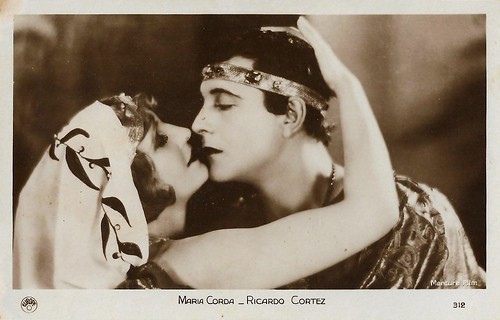
French postcard by Europe, no. 312. Photo: Mercure Film. Maria Corda and Ricardo Cortez in The Private Life of Helen of Troy (Alexander Korda, 1927).
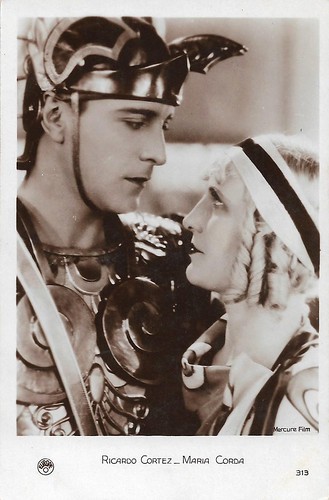
French postcard by Europe, no. 313. Photo: Mercure Film. Maria Corda and Ricardo Cortez in The Private Life of Helen of Troy (Alexander Korda, 1927).
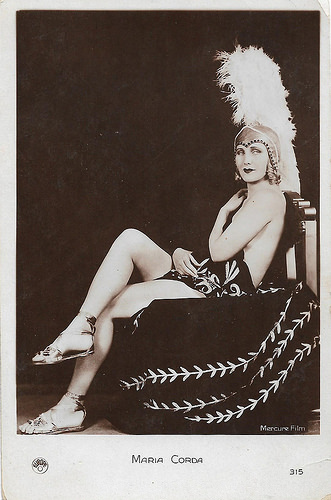
French postcard by Europe, no. 315. Photo: Mercure Film. Maria Corda as Helen of Troy in The Private Life of Helen of Troy (Alexander Korda, 1927).
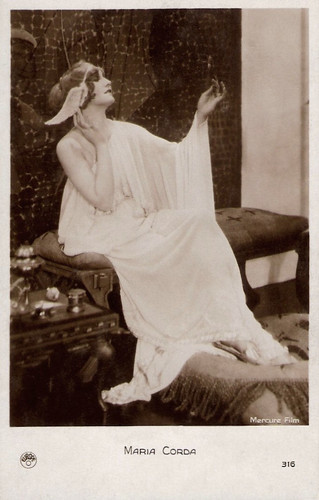
French postcard by Europe, no. 316. Photo: Mercure Film. Maria Corda as Helen of Troy in The Private Life of Helen of Troy (Alexander Korda, 1927).
A fetchingly underdressed coquette, oblivious to all the political turmoil she's causing
In the American historical epic The Private Life of Helen of Troy (1927) stars Maria Corda as the legendary Queen Helen of Troy. The film was based on the 1925 novel of the same name by John Erskine and the play 'The Road to Rome' by Robert E. Sherwood, and it was adapted to screen by Carey Wilson with intertitles by Gerald Duffy, Ralph Spence and Casey Robinson.
In response to her husband Menelaus' (Lewis Stone) lack of interest in her, Helena elopes with Paris (Ricardo Cortez) to Sparta. Menelaus, egged on by his henchman, starts a war with Paris, finally effecting the return of Helen. The time-honoured custom demands that he have the pleasure of killing her, but her seductive loveliness restrains him. And so at the end of the story, we find Helen engaging in a new flirtation with the Prince of Ithaca, while Menelaus happily goes fishing.
The cast also included George Fawcett as Eteoneus, Alice White as Adraste, Bill Elliott as Telemachus and Hungarian actor Károly Huszár , credited here as Charles Puffy , as Malapokitoratoreadetos.
The film was produced by Carey Wilson for Richard A. Rowland Productions and was distributed by First National Pictures. Director George Fitzmaurice started the film, was fired and replaced by Hungarian-born Alexander Korda. The remarkable costumes were designed by Max Rée. Special effects by Ralph Hammaras. Cinematography was done by Lee Garmes and Sid Hickox (Sydney Hickox).
In 1928, the year of the Academy Awards' inception, The Private Life of Helen of Troy was nominated for an Oscar. According to an author at IMDb , it was for 'Engineering Effects', what we call now Special Effects or Special Visual Effects. According to Wikipedia , it was nominated in the short-lived category of 'Best Title Writing'. Wikipedia is right, according to the database at Oscars.org , Gerald Duffy was nominated for WRITING (Title Writing). The category was dropped by the second Academy Awards. Gerald Duffy had died on 25 June 1928, and he was the first person to be posthumously nominated for an Academy Award.
The film was a significant success for Korda. Hal Erickson at AllMovie : "Setting the standard for his later light-hearted biopics The Private Life of Henry VIII and Rembrandt, producer-director Alexander Korda steadfastly refuses to take any of The Private Life of Helen of Troy seriously. Maria Corda , wife of the director, plays the title character as a fetchingly underdressed coquette, oblivious to all the political turmoil she's causing."
Variety: "Helen [based on the novel by John Erskine] is all comedy. Satirizing ancient myth in general and Helen's affairs particularly, the titles are topical, while the music is mainly based on pop dance tunes. Wheeling the giant wooden horse inside the gates of Troy is accomplished to the strains of 'Horses, Horses, Horses', etc."
The Private Life of Helen of Troy survives only partially at the British Film Institute (BFI). Two sections from the beginning and end, running about 27–30 minutes in total, survive there.
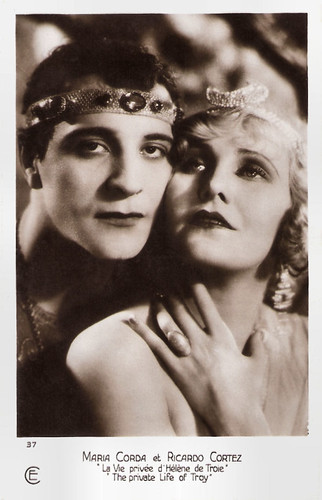
French postcard by Cinémagazine-Edition, no. 37. Photo: publicity still for The Private Life of Helen of Troy (Alexander Korda, 1927).
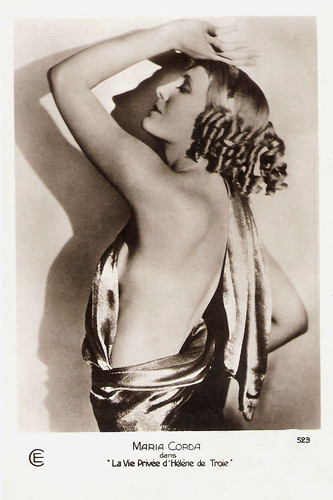
French postcard by Editions Cinémagazine, no. 523. Maria Corda as Helen of Troy in The Private Life of Helen of Troy (Alexander Korda, 1927).
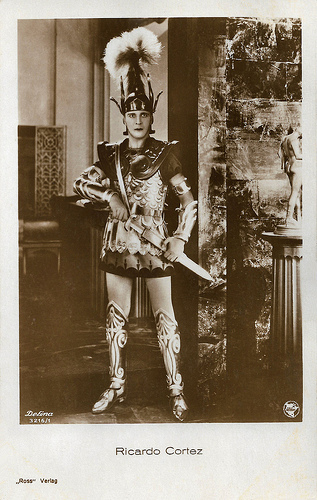
German postcard by Ross Verlag, no. 3216/1, 1928-1929. Photo: Defina / First national. Ricardo Cortez in The Private Life of Helen of Troy (Alexander Korda, 1927).
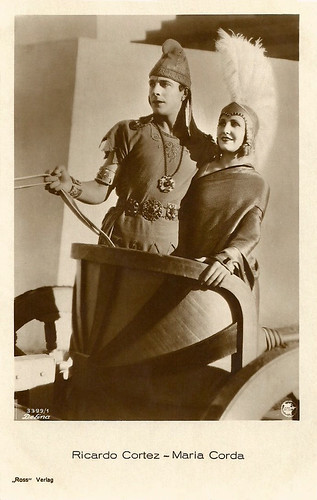
German postcard by Ross Verlag, no. 3399/1. Photo: Defina. Maria Corda and Ricardo Cortez as Helena and Paris in The Private Life of Helen of Troy (Alexander Korda, 1927).
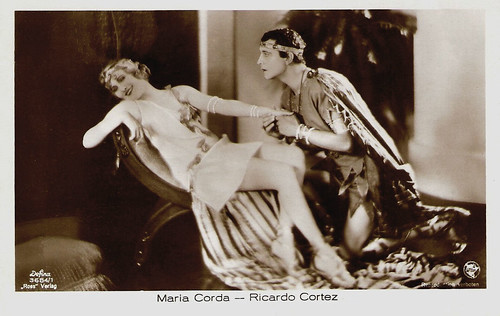
German postcard by Ross Verlag, no. 3684/1, 1928-1929. Photo: Defina. Maria Corda and Ricardo Cortez in The Private Life of Helen of Troy (Alexander Korda, 1927).
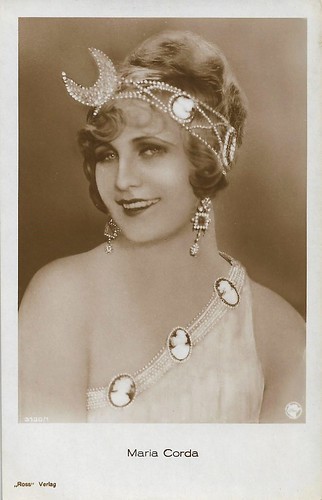
German postcard by Ross Verlag, no. 3780/1, 1928-1929. Photo: First National. Maria Corda in The Private Life of Helen of Troy (Alexander Korda, 1927).
Sources: Hal Erickson (AllMovie), Variety, Silent Era, Oscars.org, Wikipedia and IMDb.

French postcard by Europe, no. 312. Photo: Mercure Film. Maria Corda and Ricardo Cortez in The Private Life of Helen of Troy (Alexander Korda, 1927).

French postcard by Europe, no. 313. Photo: Mercure Film. Maria Corda and Ricardo Cortez in The Private Life of Helen of Troy (Alexander Korda, 1927).

French postcard by Europe, no. 315. Photo: Mercure Film. Maria Corda as Helen of Troy in The Private Life of Helen of Troy (Alexander Korda, 1927).

French postcard by Europe, no. 316. Photo: Mercure Film. Maria Corda as Helen of Troy in The Private Life of Helen of Troy (Alexander Korda, 1927).
A fetchingly underdressed coquette, oblivious to all the political turmoil she's causing
In the American historical epic The Private Life of Helen of Troy (1927) stars Maria Corda as the legendary Queen Helen of Troy. The film was based on the 1925 novel of the same name by John Erskine and the play 'The Road to Rome' by Robert E. Sherwood, and it was adapted to screen by Carey Wilson with intertitles by Gerald Duffy, Ralph Spence and Casey Robinson.
In response to her husband Menelaus' (Lewis Stone) lack of interest in her, Helena elopes with Paris (Ricardo Cortez) to Sparta. Menelaus, egged on by his henchman, starts a war with Paris, finally effecting the return of Helen. The time-honoured custom demands that he have the pleasure of killing her, but her seductive loveliness restrains him. And so at the end of the story, we find Helen engaging in a new flirtation with the Prince of Ithaca, while Menelaus happily goes fishing.
The cast also included George Fawcett as Eteoneus, Alice White as Adraste, Bill Elliott as Telemachus and Hungarian actor Károly Huszár , credited here as Charles Puffy , as Malapokitoratoreadetos.
The film was produced by Carey Wilson for Richard A. Rowland Productions and was distributed by First National Pictures. Director George Fitzmaurice started the film, was fired and replaced by Hungarian-born Alexander Korda. The remarkable costumes were designed by Max Rée. Special effects by Ralph Hammaras. Cinematography was done by Lee Garmes and Sid Hickox (Sydney Hickox).
In 1928, the year of the Academy Awards' inception, The Private Life of Helen of Troy was nominated for an Oscar. According to an author at IMDb , it was for 'Engineering Effects', what we call now Special Effects or Special Visual Effects. According to Wikipedia , it was nominated in the short-lived category of 'Best Title Writing'. Wikipedia is right, according to the database at Oscars.org , Gerald Duffy was nominated for WRITING (Title Writing). The category was dropped by the second Academy Awards. Gerald Duffy had died on 25 June 1928, and he was the first person to be posthumously nominated for an Academy Award.
The film was a significant success for Korda. Hal Erickson at AllMovie : "Setting the standard for his later light-hearted biopics The Private Life of Henry VIII and Rembrandt, producer-director Alexander Korda steadfastly refuses to take any of The Private Life of Helen of Troy seriously. Maria Corda , wife of the director, plays the title character as a fetchingly underdressed coquette, oblivious to all the political turmoil she's causing."
Variety: "Helen [based on the novel by John Erskine] is all comedy. Satirizing ancient myth in general and Helen's affairs particularly, the titles are topical, while the music is mainly based on pop dance tunes. Wheeling the giant wooden horse inside the gates of Troy is accomplished to the strains of 'Horses, Horses, Horses', etc."
The Private Life of Helen of Troy survives only partially at the British Film Institute (BFI). Two sections from the beginning and end, running about 27–30 minutes in total, survive there.

French postcard by Cinémagazine-Edition, no. 37. Photo: publicity still for The Private Life of Helen of Troy (Alexander Korda, 1927).

French postcard by Editions Cinémagazine, no. 523. Maria Corda as Helen of Troy in The Private Life of Helen of Troy (Alexander Korda, 1927).

German postcard by Ross Verlag, no. 3216/1, 1928-1929. Photo: Defina / First national. Ricardo Cortez in The Private Life of Helen of Troy (Alexander Korda, 1927).

German postcard by Ross Verlag, no. 3399/1. Photo: Defina. Maria Corda and Ricardo Cortez as Helena and Paris in The Private Life of Helen of Troy (Alexander Korda, 1927).

German postcard by Ross Verlag, no. 3684/1, 1928-1929. Photo: Defina. Maria Corda and Ricardo Cortez in The Private Life of Helen of Troy (Alexander Korda, 1927).

German postcard by Ross Verlag, no. 3780/1, 1928-1929. Photo: First National. Maria Corda in The Private Life of Helen of Troy (Alexander Korda, 1927).
Sources: Hal Erickson (AllMovie), Variety, Silent Era, Oscars.org, Wikipedia and IMDb.
Published on April 28, 2019 22:00
April 27, 2019
Ellen Schwiers (1930-2019)
Last Friday, 26 April 2019, German film and stage actress Ellen Schwiers passed away at the age of 88. The versatile actress often appeared as the dark, passionate woman, enmeshed in her own sensuality or another fate. During her 60 year-career she played in ca. 50 films and 150 television productions, but she also worked as a stage actress, director and intendant.
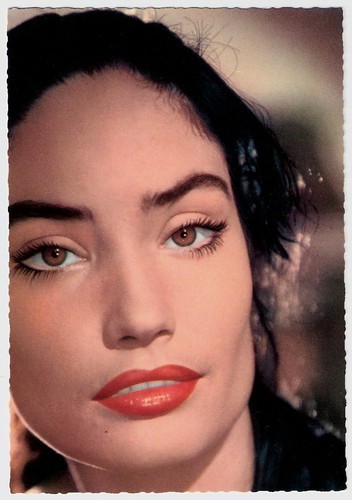
German postcard by ISV, no. M 2. Photo: Europa-Film / List.
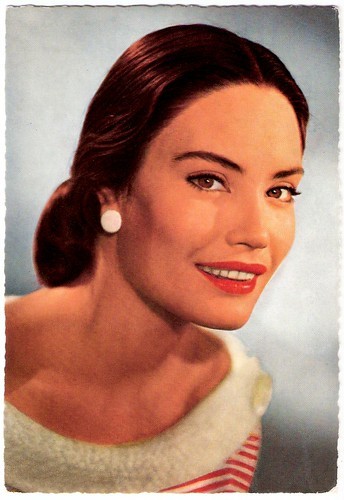
German postcard by WS-Druck, Wanne-Eickel, no. F 117. Photo: Bayer.
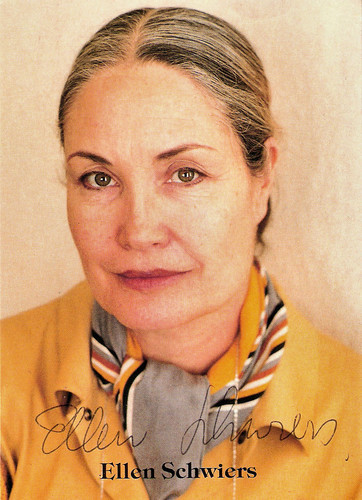
German autograph card by Simon Offset, München. Photo: Virginia.
Seven-year-contract
Ellen Schwiers was born in Stettin, Germany (now Szczecin, Poland) in 1930. She was the daughter of stage actor Lutz Schwiers. Her brother, Holger Schwiers, was also an actor.
Ellen was trained to be a baker and a gardener, and before her breakthrough as an actress, she worked as a prompt. Her father gave her acting classes and she made her first stage appearance at the Stadttheater in Koblenz. Engagements in München (Munich), Frankfurt a.M., Göttingen and Zürich followed.
In 1949 she made her film debut in the romance Heimliches Rendezvous/Secret Rendezvous (Kurt Hoffmann, 1949). In the following sixty years she would play dozens of film roles.
She had her breakthrough in the cinema in the mid-1950s. She then appeared in box office hits like the war drama 08/15–2. Teil/ 08/15 Part 2 (Paul May, 1955), Anastasia – Die letzte Zarentochter/Anastasia: The Czar's Last Daughter (Falk Harnack, 1956) with Lilli Palmer , Skandal um Dr. Vlimmen/Dr. Vlimmen (Arthur Maria Rabenalt, 1956) and the Oscar nominated comedy Helden/Arms and the Man (Franz Peter Wirth, 1958) with O.W. Fischer and Lilo Pulver .
In France she appeared opposite Fernandel in the classic comedy La vache et le prisonnier/The Cow and I (Henri Verneuil, 1959). She was offered a seven-year-contract by a major Hollywood studio, but she refused to move to Los Angeles due to her family.
She was married to film producer Peter Jacob (the ex of Leni Riefenstahl) from 1952 till his death in 1992. They had two children, actress Katerina Jacob (1958) and actor Daniel Jacob (1963). Daniel died tragically from a tumor in 1985, only 21 years old.
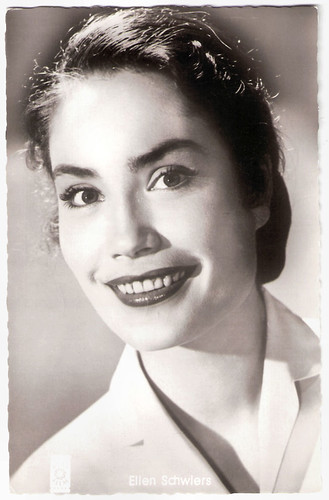
German postcard by Kolibri-Verlag, Wanne-Eickel, no. 2143. Photo: Real / Rank Film / Gabriele. Ellen Schwiers in Skandal um Dr. Vlimmen/Dr. Vlimmen (Arthur Maria Rabenalt, 1956).
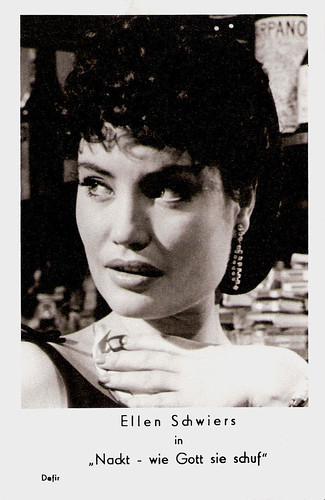
German postcard. Photo: Defir. Ellen Schwiers in Nackt, wie Gott sie schuf/Naked, how God created them (Hans Schott-Schöbinger, 1958).
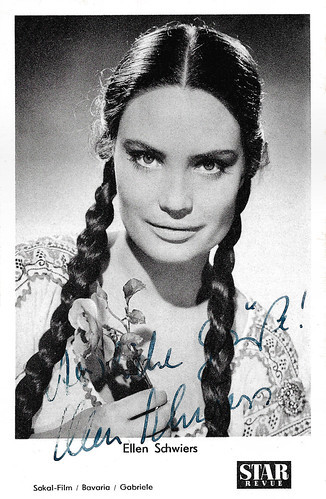
German collectors card in the Star Revue series. Photo: Sokal Film / Bavaria / Gabriele. Ellen Schwiers in Helden/Arms and the Man (Franz Peter Wirth, 1958).
Problematic, Seductive Women
Ellen Schwiers often played problematic, seductive women, who stir up the well-ordered community like in Das Erbe von Björndal/Heritage of Bjorndal (Gustav Ucicky, 1960), the Krimi Der letzte Zeuge/The Last Witness (Wolfgang Staudte, 1960), Frau Irene Besser/Mrs Irene Besser (John Olden, 1960), and Der Satan mit den roten Haaren/Red-haired Satan (Alfons Stummer, 1964).
One of her best parts was Buhlschaft in the film adaptation of Hugo von Hofmannsthal’s Jedermann/Everyman (Gottfried Reinhardt, 1961) opposite Walter Reyer .
When the German film industry got in a crisis during the 1960s, she started to focus on television, and appeared in such hit series as Derrick and Tatort. On stage she starred as Lady Macbeth in William Shakespeare’s Macbeth (1972) or Lysistrata in Hochhuth’s Lysistrata und die Nato (1974).
During the 1970s she appeared in the international productions Novecento/1900 (Bernardo Bertolucci, 1976) - as the aunt of Robert de Niro , and Fedora (Billy Wilder, 1978) with William Holden, Marthe Keller and Hildegard Knef .
In 1982 Ellen Schwiers founded Das Ensemble Jacob-Schwiers together with her husband and her daughter. She managed this theatre ensemble, for which she also directed plays.
Her last feature film was Scarmour (Sikander Goldau, 1997). She regularly appeared on German television. Recent TV-films were the thriller Mord am Meer/Murder at the Lake (Matti Geschonneck, 2005), the tragi-comedy Mein Vater und ich/My Father and I (Rolf Silber, 2005) with Dietmar Schönherr , and Eine Liebe in Königsberg/A Love in Königsberg (Peter Kahane, 2005).
In 2009 she appeared in the popular crime series SOKO 5113 and in 2011 in in the TV dramas In den besten Jahren/In the Best Years (Hartmut Schoen, 2006) with Senta Berger , and Im Fluss des Lebens/In the river of life (Wolf Gremm, 2011) with her daughter Katerina Jacob.
Ellen Schwiers was awarded the Bundesverdienstkreuz in 1989. On 26 April 2019, she passed away in Berg am Starnberger See, Bavaria, at the age of 88. Actress Josephine Jacob is her granddaughter.
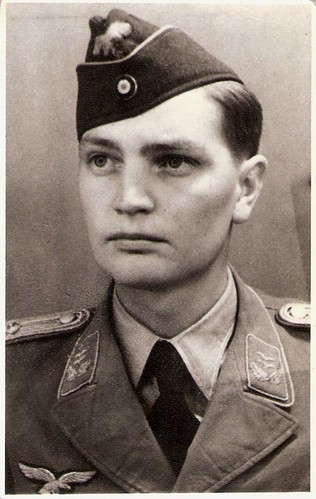
German photo.
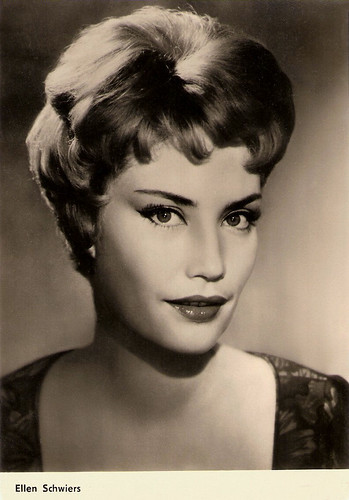
East-German postcard by VEB Progress Film-Vertrieb, Berlin, no. 1679, 1962.
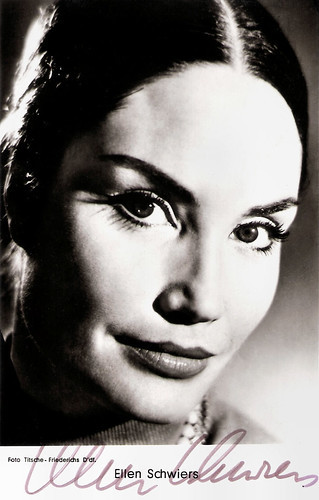
German autograph card. Photo: Titsche-Friederichs, Düsseldorf.
Sources: Stephanie D'heil (Steffi-line.de - German), Prisma (German), Wikipedia (German), and .

German postcard by ISV, no. M 2. Photo: Europa-Film / List.

German postcard by WS-Druck, Wanne-Eickel, no. F 117. Photo: Bayer.

German autograph card by Simon Offset, München. Photo: Virginia.
Seven-year-contract
Ellen Schwiers was born in Stettin, Germany (now Szczecin, Poland) in 1930. She was the daughter of stage actor Lutz Schwiers. Her brother, Holger Schwiers, was also an actor.
Ellen was trained to be a baker and a gardener, and before her breakthrough as an actress, she worked as a prompt. Her father gave her acting classes and she made her first stage appearance at the Stadttheater in Koblenz. Engagements in München (Munich), Frankfurt a.M., Göttingen and Zürich followed.
In 1949 she made her film debut in the romance Heimliches Rendezvous/Secret Rendezvous (Kurt Hoffmann, 1949). In the following sixty years she would play dozens of film roles.
She had her breakthrough in the cinema in the mid-1950s. She then appeared in box office hits like the war drama 08/15–2. Teil/ 08/15 Part 2 (Paul May, 1955), Anastasia – Die letzte Zarentochter/Anastasia: The Czar's Last Daughter (Falk Harnack, 1956) with Lilli Palmer , Skandal um Dr. Vlimmen/Dr. Vlimmen (Arthur Maria Rabenalt, 1956) and the Oscar nominated comedy Helden/Arms and the Man (Franz Peter Wirth, 1958) with O.W. Fischer and Lilo Pulver .
In France she appeared opposite Fernandel in the classic comedy La vache et le prisonnier/The Cow and I (Henri Verneuil, 1959). She was offered a seven-year-contract by a major Hollywood studio, but she refused to move to Los Angeles due to her family.
She was married to film producer Peter Jacob (the ex of Leni Riefenstahl) from 1952 till his death in 1992. They had two children, actress Katerina Jacob (1958) and actor Daniel Jacob (1963). Daniel died tragically from a tumor in 1985, only 21 years old.

German postcard by Kolibri-Verlag, Wanne-Eickel, no. 2143. Photo: Real / Rank Film / Gabriele. Ellen Schwiers in Skandal um Dr. Vlimmen/Dr. Vlimmen (Arthur Maria Rabenalt, 1956).

German postcard. Photo: Defir. Ellen Schwiers in Nackt, wie Gott sie schuf/Naked, how God created them (Hans Schott-Schöbinger, 1958).

German collectors card in the Star Revue series. Photo: Sokal Film / Bavaria / Gabriele. Ellen Schwiers in Helden/Arms and the Man (Franz Peter Wirth, 1958).
Problematic, Seductive Women
Ellen Schwiers often played problematic, seductive women, who stir up the well-ordered community like in Das Erbe von Björndal/Heritage of Bjorndal (Gustav Ucicky, 1960), the Krimi Der letzte Zeuge/The Last Witness (Wolfgang Staudte, 1960), Frau Irene Besser/Mrs Irene Besser (John Olden, 1960), and Der Satan mit den roten Haaren/Red-haired Satan (Alfons Stummer, 1964).
One of her best parts was Buhlschaft in the film adaptation of Hugo von Hofmannsthal’s Jedermann/Everyman (Gottfried Reinhardt, 1961) opposite Walter Reyer .
When the German film industry got in a crisis during the 1960s, she started to focus on television, and appeared in such hit series as Derrick and Tatort. On stage she starred as Lady Macbeth in William Shakespeare’s Macbeth (1972) or Lysistrata in Hochhuth’s Lysistrata und die Nato (1974).
During the 1970s she appeared in the international productions Novecento/1900 (Bernardo Bertolucci, 1976) - as the aunt of Robert de Niro , and Fedora (Billy Wilder, 1978) with William Holden, Marthe Keller and Hildegard Knef .
In 1982 Ellen Schwiers founded Das Ensemble Jacob-Schwiers together with her husband and her daughter. She managed this theatre ensemble, for which she also directed plays.
Her last feature film was Scarmour (Sikander Goldau, 1997). She regularly appeared on German television. Recent TV-films were the thriller Mord am Meer/Murder at the Lake (Matti Geschonneck, 2005), the tragi-comedy Mein Vater und ich/My Father and I (Rolf Silber, 2005) with Dietmar Schönherr , and Eine Liebe in Königsberg/A Love in Königsberg (Peter Kahane, 2005).
In 2009 she appeared in the popular crime series SOKO 5113 and in 2011 in in the TV dramas In den besten Jahren/In the Best Years (Hartmut Schoen, 2006) with Senta Berger , and Im Fluss des Lebens/In the river of life (Wolf Gremm, 2011) with her daughter Katerina Jacob.
Ellen Schwiers was awarded the Bundesverdienstkreuz in 1989. On 26 April 2019, she passed away in Berg am Starnberger See, Bavaria, at the age of 88. Actress Josephine Jacob is her granddaughter.

German photo.

East-German postcard by VEB Progress Film-Vertrieb, Berlin, no. 1679, 1962.

German autograph card. Photo: Titsche-Friederichs, Düsseldorf.
Sources: Stephanie D'heil (Steffi-line.de - German), Prisma (German), Wikipedia (German), and .
Published on April 27, 2019 22:00
April 26, 2019
Photo by Bavaria Filmkunst
100 years ago Bavaria Film in Munich was founded. The German studio is still one of Europe's largest film production companies, with some 30 subsidiaries. Many famous, international films were made here, including Alfred Hitchcock's film debut. For this post, we focus on the Nazi period, when 'Bavaria Filmkunst' became one of the four major film companies of Germany.
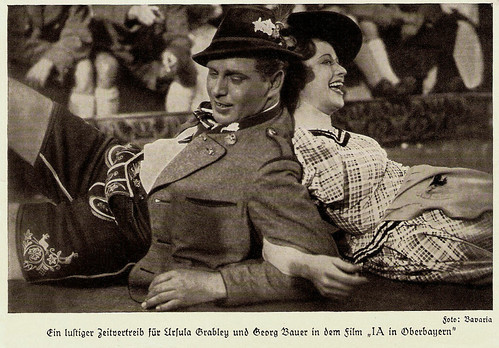
German card. Photo: Bavaria. Publicity still for IA in Oberbayern/1A in Upper Bavaria (1937, Frans Seitz). Caption: "Ein lustiger Zeitvertreib für Ursula Grabley und Georg Bauer in dem film IA in Oberbayern". (A fun pastime for Ursula Grabley and Georg Bauer in the film IA in Oberbayern/1A in Upper Bavaria).
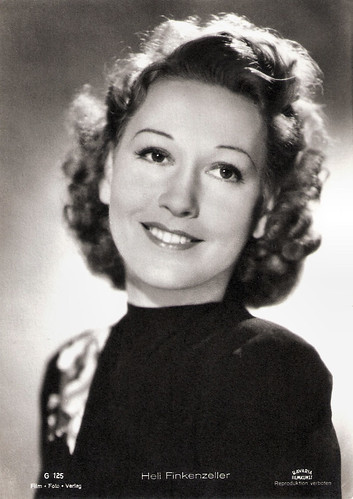
Heli Finkenzeller. German postcard by Film-Foto-Verlag, no. G 125, Photo: Bavaria Filmkunst.
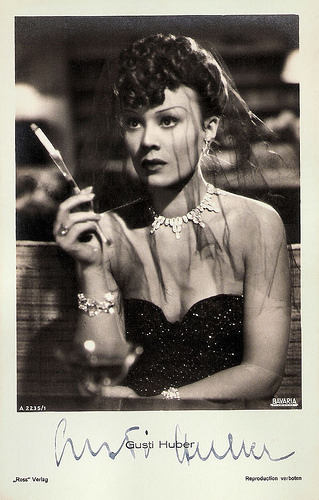
Gusti Huber . German postcard by Ross-Verlag, no. A 2235/1, 1939-1940. Photo: Bavaria Filmkunst.
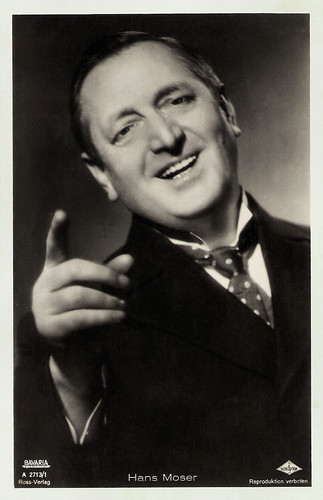
Hans Moser . German postcard by Ross Verlag, no. A 2713/1, 1939-1940. Photo: Bavaria Filmkunst / Wien Film. Publicity still for Anton, der Letzte/Anthony the Last (E.W. Emo, 1939).
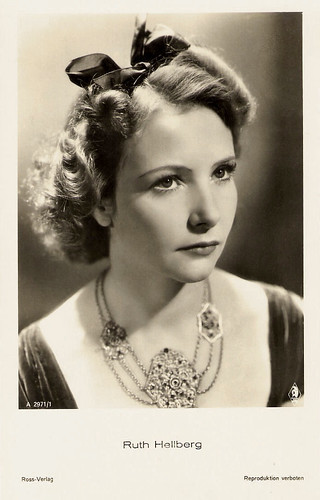
Ruth Hellberg . German postcard by Ross Verlag, no. A 2971/1, 1939-1940. Photo: Bavaria Film-Kunst.
Alfred Hitchcock's film debut
The Bavaria Film studios were founded as Münchener Lichtspielkunst GmbH in 1919. Then Munich-raised film producer Peter Ostermayr converted the private film company he had started in 1907, Münchener Lichtspielkunst GmbH, to the public company Münchener Lichtspielkunst AG (Emelka).
He acquired a large area (ca. 356.000 m²) for the studios in Geiselgasteig, a district of Munich's southern suburb Grünwald. He built a glass studio there. The company was a direct competitor to Ufa, which had started in Berlin in 1917, and it quickly absorbed several other film industry companies in the region. The first film shot in Geiselgasteig was Der Ochsenkrieg/The Ox War (Franz Osten, 1920).
Many well-known silent films were made in the studios, including the costume film Monna Vanna (Richard Eichberg, 1922), starring Paul Wegener and Lee Parry , the Indo-European co-production Prem Sanyas/The Light of Asia (Franz Osten, Himanshu Rai, 1925) about the origin of the Buddha, and also British director Alfred Hitchcock made here his first film, The Pleasure Garden (1925).
The last large-scale production Waterloo (Karl Grune, 1928), starring Otto Gebühr , ushered in the bankruptcy of the Emelka and the transition to Bavaria. From 24 September 1930, Emelka produced in addition to the films also a weekly newsreel, the 'Tönende Emelka-Wochenschau'. Director Max Ophüls made his musical comedy Die verkaufte Braut/The Bartered Bride (Max Ophüls, 1932) starring Jarmila Novotná . When Bavaria's theatre chain financially did not survive the conversion to sound film, Emelka had to declare bankruptcy in November 1932.
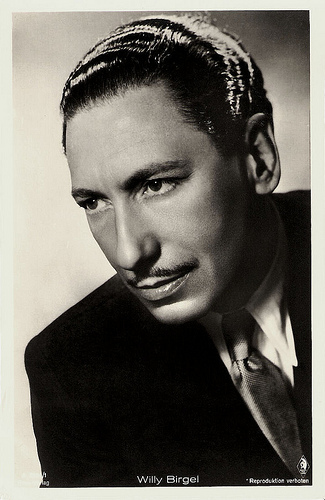
Willy Birgel . German postcard by Ross Verlag, no. A 2991/1, 1939-1940. Photo: Bavaria Filmkunst.
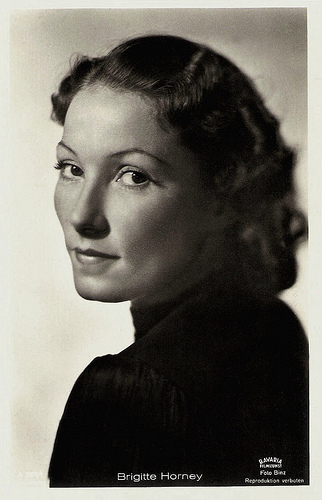
Brigitte Horney . German postcard by Ross-Verlag, no. 3378/1, 1941-1944. Photo: Binz / Bavaria Filmkunst.
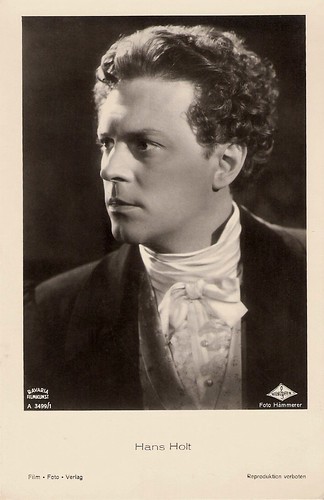
Hans Holt . German postcard by Film-Foto-Verlag, no. A 3499/1, 1941-1944. Photo: Hämmerer / Wien-Film / Bavaria Filmkunst.
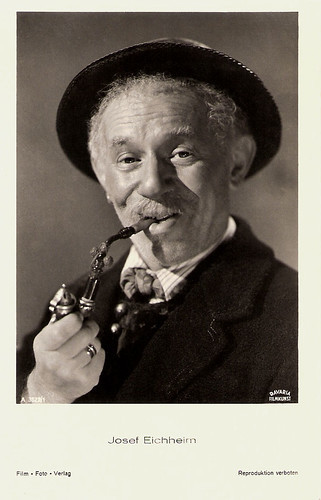
Josef Eichheim . German postcard by Film-Foto-Verlag, no. A 3528/1, 1941-1944. Photo: Bavaria Filmkunst.
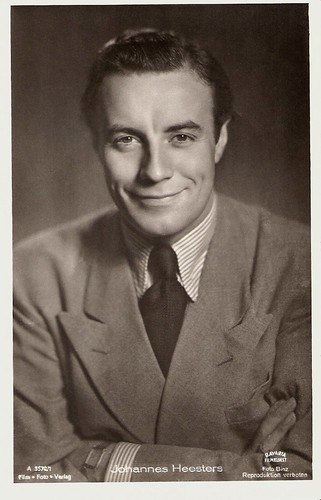
Johannes Heesters . German postcard by Film-Foto-Verlag, no. A 3570/1, 1941-1944. Photo: Binz/Bavaria Filmkunst. Collection: Egbert Barten.
Suddenly We're in Powell and Pressburger Territory
In 1930, investor Wilhelm Kraus and a consortium of banks bought a major shareholding in the company, and on 21 September 1932 the group took control of the company and renamed it Bavaria Film AG. After the National Socialists seizure of power in January 1933, a number of longtime Bavaria employees left the country, including the directors Ewald André Dupont, Karl Grune, Max Ophüls, the cinematographer Franz Planner and the actors Therese Giehse and Fritz Kortner .
Director Kurt Bernhardt (also known as Curtis Bernhardt) directed the French-German science fiction film Der Tunnel/The Tunnel (Kurt Bernhardt, 1933) starring Paul Hartmann and Attila Hörbiger . It is an adaptation of Bernhard Kellermann's 1913 novel 'Der Tunnel' about the construction of a vast tunnel under the Atlantic Ocean connecting Europe and America.A separate French version was also produced. In 1935 the film was remade in Britain as The Tunnel/Transatlantic Tunnel (Maurice Elvey, 1935). The British film was released in the United States.
In 1934, the drama Peer Gynt (Fritz Wendhausen, 1934) was made at the Bavaria studios. Peer Gynt starred Hans Albers , Lucie Höflich and Marieluise Claudius, and it is based on the play 'Peer Gynt' by Henrik Ibsen. It was one of the most expensive productions made by Bavaria Film and involved location shooting in Norway. The film's sets were designed by the art directors Karl Vollbrecht and Hermann Warm.
After the Bavaria got into difficulties in 1936 and had to stop its payments in the spring of 1937, Bavaria Film was nationalised. The Bavaria Filmkunst GmbH was founded on 11 February 1938 with political support from Berlin. Shareholders were the notorious firm Cautio Treuhand and the General Film Trust (AFT), a wealthy company that held their shares in trust for the Cautio.
In 1939, Hans Albers starred in the Western Wasser für Canitoga/Water for Canitoga (Herbert Selpin, 1939) with Charlotte Susa and Josef Sieber. The film is in fact a 'Northern', set in Canada in 1905 where an engineer is working to construct a new water supply system despite repeated attempts at sabotage. The film's sets were designed by the art directors Wilhelm Depenau, Ludwig Reiber and Arthur Schwarz.
On 19 February 1941, however, Bavaria was relinquished to the Berlin Film Finance Company. The production facilities remained in Munich, but the company was now controlled from Berlin. On 10 January 1942, the Cautio also withdrew its Bavaria shares, and Film Finanz, which now owned all shares in Bavaria Filmkunst, was simultaneously transformed into the Ufa film (UFI). In the state-owned monopoly group UFI Bavaria had from 1942 on only formal independence.
Managing Director and Production Manager of the Bavaria were Hans Schweikart from 1938 to 1942, Erich Walter Herbell, Helmut Schreiber and Helmut Keil. Production group leaders were Hans Abich, Fred Lyssa, Oskar Marion , Ottmar Ostermayr, Ernst Rechenmacher and Gerhard Staab.
Popular were the comedies with Hans Moser and Theo Lingen , like Sieben Jahre Glück/Seven Years Luck (Ernst Marischka, 1942), in which they co-starred with Wolf Albach-Retty and Hannelore Schroth . But also romantic comedies such as Reise in die Vergangenheit/Trip to the past (Hans H. Zerlett, 1943), starring Olga Tschechowa and Ferdinand Marian , Es lebe die Liebe (Erich Engel, 1944), with Lizzi Waldmüller and the Dutch tenor Johannes Heesters , or Ich brauche dich (1944), starring Marianne Hoppe and Willy Birgel .
Famous director G.W. Pabst made the interesting Paracelsus (1943) with Werner Krauss at Bavaria. It is a celebratory film about the 'revolutionary' 16th century German philosopher/doctor known as Paracelsus ( Werner Krauss ). Reviewer MAK-4 at IMDb : "Though Pabst's sound films never achieved the prominence of his silent work, this is a well produced biopic with real surprises, especially when Paracelsus gives credit to Gypsy (!) folk remedies or when an Expressionist dance number symbolizes the entry of the plague (St. Vitus' Dance) into the closed town. Suddenly we're in Powell/Pressburger territory."
Other Bavaria films made during the final years of the Third Reich were the crime films Der Täter ist unter uns/The culprit is among us (Herbert B. Fredersdorf, 1944) with Paul Dahlke and Margot Hielscher , and Orient-Express (Viktor Tourjansky, 1944), starring Siegfried Breuer and Gusti Wolf. Popular was also the drama Das Lied der Nachtigall (Theo Lingen, 1944) with Elfie Mayerhofer , Johannes Riemann , and Paul Kemp.
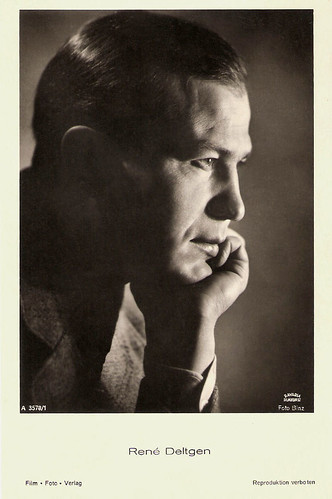
René Deltgen . German postcard by Film-Foto-Verlag, no. A 3578/1, 1941-1944. Photo: Binz / Bavaria Filmkunst.
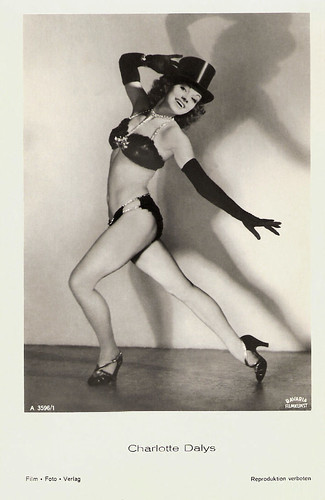
Charlotte Dalys. German Postcard by Film-Foto-Verlag, no. A 3596/1, 1941-1944. Photo: Bavaria Filmkunst.
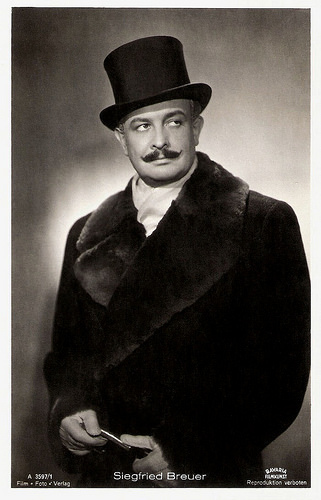
Siegfried Breuer . German postcard by Film-Foto-Verlag, no. A 3597/1, 1941-1944. Photo: Bavaria Filmkunst.
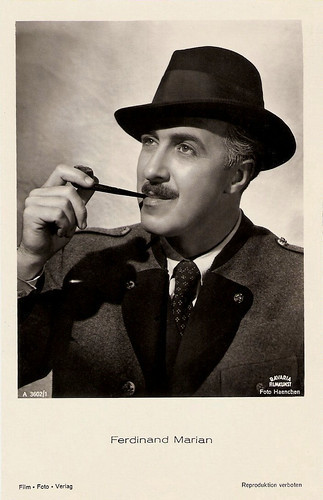
Ferdinand Marian . German postcard by Film-Foto-Verlag, no. A 3602/1, 1941-1944. Photo: Haenchen / Bavaria Filmkunst. Collection: Geoffrey Donaldson Institute.
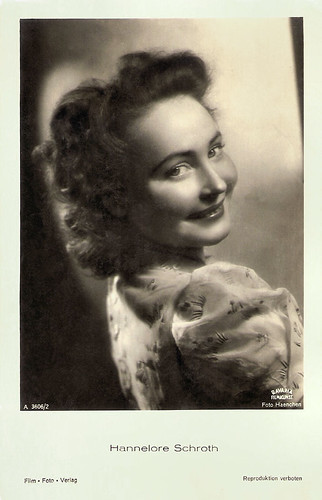
Hannelore Schroth . German postcard by Film-Foto-Verlag, no. A 3606/2, 1941-1944. Photo: Haenchen / Bavaria Filmkunst.
The Sound of Music
The studios of the Bavaria Film remained undamaged in the war. On 10 May 1945, they were subordinated to the American army, which initially forbade Bavaria Filmkunst any production activity of its own. Only the film lab, which also set up a colour department in 1952, and the dubbing studio were allowed to continue to operate and soon resumed their work. In addition, a rental company - General Film Distribution, AFI for short - was founded on the premises.
After 1945, Bavaria was lead by the managing directors Helmut Jedele and Günter Rohrbach. Later CEOs were Thilo Kleine, Dieter Frank and Matthias Esche. The American military government allowed Bavaria to rent its studios to other production companies.
During the 1950s, the Bavaria studios have been used by numerous famous directors, such as Elia Kazan for Man on a Tightrope (1952), Max Ophüls for Lola Montès (1954), Stanley Kubrick for Paths of Glory (1957), Richard Fleischer for The Vikings (1958), John Huston for Freud: The Secret Passion (1960) and Robert Siodmak for L'Affaire Nina B (1960). Bavaria Film was privatised again in 1956.
During the 1960s the studio was again for such international productions as One, Two, Three (Billy Wilder, 1961) with James Cagney, The Great Escape (John Sturges, 1963) with Steve McQueen, The Sound of Music (Robert Wise, 1965) starring Julie Andrews , The Deep (Orson Welles, 1967), and Deep End (Jerzy Skolimowski, 1970).
The Studios in Geiselgasteig are the reason why Munich has become a famous site of crime in TV fiction (in opposite to real life), with Krimi-series like Derrick, Der Alte/The Old Fox, and Der Kommissar.
Also Monty Python worked in Geiselgasteig in 1971 and 1972 for Monty Python's Fliegender Zirkus (Mont Python's Flying Circus), two specials for German and Austrian television. In addition to recreating classic sketches as 'The Lumberjack Song', several new sketches were written specifically for this show, such as 'Little Red Riding Hood', 'William Tell' and a herd of cows doing 'Merchant of Venice'.
In these years, again many top directors worked in the Bavaria Studios: Bob Fosse directed Cabaret (1972), Wim Wenders made the two TV films Ein Haus für uns/A House for Us (1974), Ingmar Bergman directed The Serpent's Egg (1977), Billy Wilder returned to make Fedora (1978) and Rainer Werner Fassbinder created here his legendary TV series Berlin Alexanderplatz (1980).
Later followed Wolfgang Petersen with Das Boot (1981) and Enemy Mine (1985), Claude Chabrol with La demoiselle d'honneur/The Bridesmaid (2004) with Laura Smet, and Oliver Stone with Snowden/The Snowden Files (2015) with Joseph Gordon-Levitt.
Other production companies have produced films in the Bavaria studios, including Constantin Film, for example The Neverending Story (Wolfgang Petersen, 1984), Der Untergang/Downfall (Oliver Hirschbiegel, 2004) with Bruno Ganz , and Perfume: The Story of a Murderer (Tom Tykwer, 2006) with Ben Whishaw and Dustin Hoffman .
Today, the company is managed by Christian Franckenstein (CEO) and Achim Rohnke. Twelve modern film and TV studios are located on the 30-acre site. Bavaria Filmstadt is an attraction offered for tourists. Visitors taking the tour see sets and props from The Neverending Story, Das Boot, and many more.
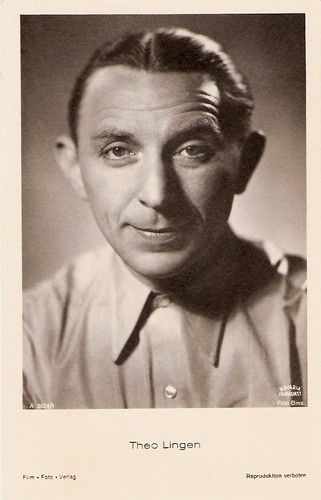
Theo Lingen . German postcard by Film-Foto-Verlag, no. A 3624/1, 1941-1944. Photo: Binz / Bavaria Filmkunst.
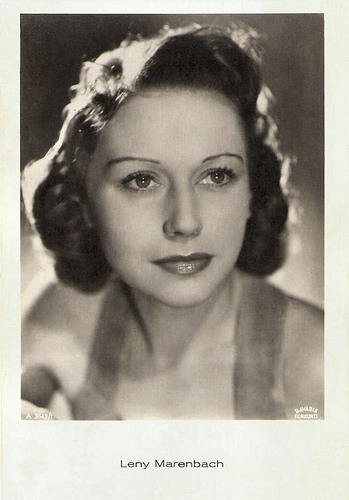
Leny Marenbach. German postcard, no. A 3643/1, 1941-1944. Photo: Bavaria Filmkunst.
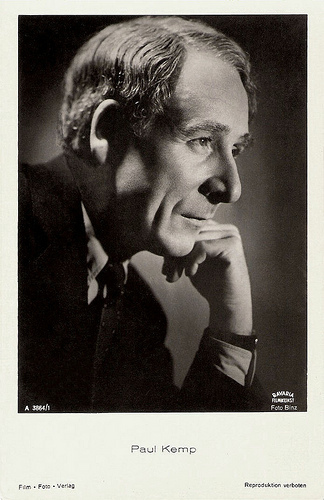
Paul Kemp . German postcard by Film-Foto-Verlag, no. 3864/1, 1941-1944. Photo: Binz / Bavaria Filmkunst.
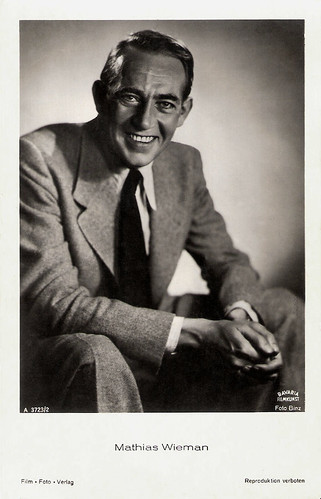
Mathias Wieman . German postcard by Film-Foto-Verlag, no. A 3723/2, 1941-1944. Photo: Binz / Bavaria Filmkunst.
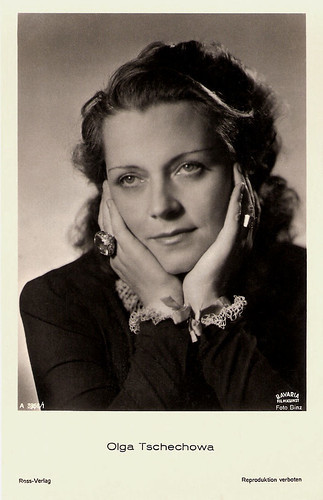
Olga Tschechowa . German postcard by Ross Verlag, no. A 3956/1, 1941-1944. Photo: Binz / Bavaria Filmkunst.
Sources: Bavaria Film, Wikipedia (English and German) and IMDb.

German card. Photo: Bavaria. Publicity still for IA in Oberbayern/1A in Upper Bavaria (1937, Frans Seitz). Caption: "Ein lustiger Zeitvertreib für Ursula Grabley und Georg Bauer in dem film IA in Oberbayern". (A fun pastime for Ursula Grabley and Georg Bauer in the film IA in Oberbayern/1A in Upper Bavaria).

Heli Finkenzeller. German postcard by Film-Foto-Verlag, no. G 125, Photo: Bavaria Filmkunst.

Gusti Huber . German postcard by Ross-Verlag, no. A 2235/1, 1939-1940. Photo: Bavaria Filmkunst.

Hans Moser . German postcard by Ross Verlag, no. A 2713/1, 1939-1940. Photo: Bavaria Filmkunst / Wien Film. Publicity still for Anton, der Letzte/Anthony the Last (E.W. Emo, 1939).

Ruth Hellberg . German postcard by Ross Verlag, no. A 2971/1, 1939-1940. Photo: Bavaria Film-Kunst.
Alfred Hitchcock's film debut
The Bavaria Film studios were founded as Münchener Lichtspielkunst GmbH in 1919. Then Munich-raised film producer Peter Ostermayr converted the private film company he had started in 1907, Münchener Lichtspielkunst GmbH, to the public company Münchener Lichtspielkunst AG (Emelka).
He acquired a large area (ca. 356.000 m²) for the studios in Geiselgasteig, a district of Munich's southern suburb Grünwald. He built a glass studio there. The company was a direct competitor to Ufa, which had started in Berlin in 1917, and it quickly absorbed several other film industry companies in the region. The first film shot in Geiselgasteig was Der Ochsenkrieg/The Ox War (Franz Osten, 1920).
Many well-known silent films were made in the studios, including the costume film Monna Vanna (Richard Eichberg, 1922), starring Paul Wegener and Lee Parry , the Indo-European co-production Prem Sanyas/The Light of Asia (Franz Osten, Himanshu Rai, 1925) about the origin of the Buddha, and also British director Alfred Hitchcock made here his first film, The Pleasure Garden (1925).
The last large-scale production Waterloo (Karl Grune, 1928), starring Otto Gebühr , ushered in the bankruptcy of the Emelka and the transition to Bavaria. From 24 September 1930, Emelka produced in addition to the films also a weekly newsreel, the 'Tönende Emelka-Wochenschau'. Director Max Ophüls made his musical comedy Die verkaufte Braut/The Bartered Bride (Max Ophüls, 1932) starring Jarmila Novotná . When Bavaria's theatre chain financially did not survive the conversion to sound film, Emelka had to declare bankruptcy in November 1932.

Willy Birgel . German postcard by Ross Verlag, no. A 2991/1, 1939-1940. Photo: Bavaria Filmkunst.

Brigitte Horney . German postcard by Ross-Verlag, no. 3378/1, 1941-1944. Photo: Binz / Bavaria Filmkunst.

Hans Holt . German postcard by Film-Foto-Verlag, no. A 3499/1, 1941-1944. Photo: Hämmerer / Wien-Film / Bavaria Filmkunst.

Josef Eichheim . German postcard by Film-Foto-Verlag, no. A 3528/1, 1941-1944. Photo: Bavaria Filmkunst.

Johannes Heesters . German postcard by Film-Foto-Verlag, no. A 3570/1, 1941-1944. Photo: Binz/Bavaria Filmkunst. Collection: Egbert Barten.
Suddenly We're in Powell and Pressburger Territory
In 1930, investor Wilhelm Kraus and a consortium of banks bought a major shareholding in the company, and on 21 September 1932 the group took control of the company and renamed it Bavaria Film AG. After the National Socialists seizure of power in January 1933, a number of longtime Bavaria employees left the country, including the directors Ewald André Dupont, Karl Grune, Max Ophüls, the cinematographer Franz Planner and the actors Therese Giehse and Fritz Kortner .
Director Kurt Bernhardt (also known as Curtis Bernhardt) directed the French-German science fiction film Der Tunnel/The Tunnel (Kurt Bernhardt, 1933) starring Paul Hartmann and Attila Hörbiger . It is an adaptation of Bernhard Kellermann's 1913 novel 'Der Tunnel' about the construction of a vast tunnel under the Atlantic Ocean connecting Europe and America.A separate French version was also produced. In 1935 the film was remade in Britain as The Tunnel/Transatlantic Tunnel (Maurice Elvey, 1935). The British film was released in the United States.
In 1934, the drama Peer Gynt (Fritz Wendhausen, 1934) was made at the Bavaria studios. Peer Gynt starred Hans Albers , Lucie Höflich and Marieluise Claudius, and it is based on the play 'Peer Gynt' by Henrik Ibsen. It was one of the most expensive productions made by Bavaria Film and involved location shooting in Norway. The film's sets were designed by the art directors Karl Vollbrecht and Hermann Warm.
After the Bavaria got into difficulties in 1936 and had to stop its payments in the spring of 1937, Bavaria Film was nationalised. The Bavaria Filmkunst GmbH was founded on 11 February 1938 with political support from Berlin. Shareholders were the notorious firm Cautio Treuhand and the General Film Trust (AFT), a wealthy company that held their shares in trust for the Cautio.
In 1939, Hans Albers starred in the Western Wasser für Canitoga/Water for Canitoga (Herbert Selpin, 1939) with Charlotte Susa and Josef Sieber. The film is in fact a 'Northern', set in Canada in 1905 where an engineer is working to construct a new water supply system despite repeated attempts at sabotage. The film's sets were designed by the art directors Wilhelm Depenau, Ludwig Reiber and Arthur Schwarz.
On 19 February 1941, however, Bavaria was relinquished to the Berlin Film Finance Company. The production facilities remained in Munich, but the company was now controlled from Berlin. On 10 January 1942, the Cautio also withdrew its Bavaria shares, and Film Finanz, which now owned all shares in Bavaria Filmkunst, was simultaneously transformed into the Ufa film (UFI). In the state-owned monopoly group UFI Bavaria had from 1942 on only formal independence.
Managing Director and Production Manager of the Bavaria were Hans Schweikart from 1938 to 1942, Erich Walter Herbell, Helmut Schreiber and Helmut Keil. Production group leaders were Hans Abich, Fred Lyssa, Oskar Marion , Ottmar Ostermayr, Ernst Rechenmacher and Gerhard Staab.
Popular were the comedies with Hans Moser and Theo Lingen , like Sieben Jahre Glück/Seven Years Luck (Ernst Marischka, 1942), in which they co-starred with Wolf Albach-Retty and Hannelore Schroth . But also romantic comedies such as Reise in die Vergangenheit/Trip to the past (Hans H. Zerlett, 1943), starring Olga Tschechowa and Ferdinand Marian , Es lebe die Liebe (Erich Engel, 1944), with Lizzi Waldmüller and the Dutch tenor Johannes Heesters , or Ich brauche dich (1944), starring Marianne Hoppe and Willy Birgel .
Famous director G.W. Pabst made the interesting Paracelsus (1943) with Werner Krauss at Bavaria. It is a celebratory film about the 'revolutionary' 16th century German philosopher/doctor known as Paracelsus ( Werner Krauss ). Reviewer MAK-4 at IMDb : "Though Pabst's sound films never achieved the prominence of his silent work, this is a well produced biopic with real surprises, especially when Paracelsus gives credit to Gypsy (!) folk remedies or when an Expressionist dance number symbolizes the entry of the plague (St. Vitus' Dance) into the closed town. Suddenly we're in Powell/Pressburger territory."
Other Bavaria films made during the final years of the Third Reich were the crime films Der Täter ist unter uns/The culprit is among us (Herbert B. Fredersdorf, 1944) with Paul Dahlke and Margot Hielscher , and Orient-Express (Viktor Tourjansky, 1944), starring Siegfried Breuer and Gusti Wolf. Popular was also the drama Das Lied der Nachtigall (Theo Lingen, 1944) with Elfie Mayerhofer , Johannes Riemann , and Paul Kemp.

René Deltgen . German postcard by Film-Foto-Verlag, no. A 3578/1, 1941-1944. Photo: Binz / Bavaria Filmkunst.

Charlotte Dalys. German Postcard by Film-Foto-Verlag, no. A 3596/1, 1941-1944. Photo: Bavaria Filmkunst.

Siegfried Breuer . German postcard by Film-Foto-Verlag, no. A 3597/1, 1941-1944. Photo: Bavaria Filmkunst.

Ferdinand Marian . German postcard by Film-Foto-Verlag, no. A 3602/1, 1941-1944. Photo: Haenchen / Bavaria Filmkunst. Collection: Geoffrey Donaldson Institute.

Hannelore Schroth . German postcard by Film-Foto-Verlag, no. A 3606/2, 1941-1944. Photo: Haenchen / Bavaria Filmkunst.
The Sound of Music
The studios of the Bavaria Film remained undamaged in the war. On 10 May 1945, they were subordinated to the American army, which initially forbade Bavaria Filmkunst any production activity of its own. Only the film lab, which also set up a colour department in 1952, and the dubbing studio were allowed to continue to operate and soon resumed their work. In addition, a rental company - General Film Distribution, AFI for short - was founded on the premises.
After 1945, Bavaria was lead by the managing directors Helmut Jedele and Günter Rohrbach. Later CEOs were Thilo Kleine, Dieter Frank and Matthias Esche. The American military government allowed Bavaria to rent its studios to other production companies.
During the 1950s, the Bavaria studios have been used by numerous famous directors, such as Elia Kazan for Man on a Tightrope (1952), Max Ophüls for Lola Montès (1954), Stanley Kubrick for Paths of Glory (1957), Richard Fleischer for The Vikings (1958), John Huston for Freud: The Secret Passion (1960) and Robert Siodmak for L'Affaire Nina B (1960). Bavaria Film was privatised again in 1956.
During the 1960s the studio was again for such international productions as One, Two, Three (Billy Wilder, 1961) with James Cagney, The Great Escape (John Sturges, 1963) with Steve McQueen, The Sound of Music (Robert Wise, 1965) starring Julie Andrews , The Deep (Orson Welles, 1967), and Deep End (Jerzy Skolimowski, 1970).
The Studios in Geiselgasteig are the reason why Munich has become a famous site of crime in TV fiction (in opposite to real life), with Krimi-series like Derrick, Der Alte/The Old Fox, and Der Kommissar.
Also Monty Python worked in Geiselgasteig in 1971 and 1972 for Monty Python's Fliegender Zirkus (Mont Python's Flying Circus), two specials for German and Austrian television. In addition to recreating classic sketches as 'The Lumberjack Song', several new sketches were written specifically for this show, such as 'Little Red Riding Hood', 'William Tell' and a herd of cows doing 'Merchant of Venice'.
In these years, again many top directors worked in the Bavaria Studios: Bob Fosse directed Cabaret (1972), Wim Wenders made the two TV films Ein Haus für uns/A House for Us (1974), Ingmar Bergman directed The Serpent's Egg (1977), Billy Wilder returned to make Fedora (1978) and Rainer Werner Fassbinder created here his legendary TV series Berlin Alexanderplatz (1980).
Later followed Wolfgang Petersen with Das Boot (1981) and Enemy Mine (1985), Claude Chabrol with La demoiselle d'honneur/The Bridesmaid (2004) with Laura Smet, and Oliver Stone with Snowden/The Snowden Files (2015) with Joseph Gordon-Levitt.
Other production companies have produced films in the Bavaria studios, including Constantin Film, for example The Neverending Story (Wolfgang Petersen, 1984), Der Untergang/Downfall (Oliver Hirschbiegel, 2004) with Bruno Ganz , and Perfume: The Story of a Murderer (Tom Tykwer, 2006) with Ben Whishaw and Dustin Hoffman .
Today, the company is managed by Christian Franckenstein (CEO) and Achim Rohnke. Twelve modern film and TV studios are located on the 30-acre site. Bavaria Filmstadt is an attraction offered for tourists. Visitors taking the tour see sets and props from The Neverending Story, Das Boot, and many more.

Theo Lingen . German postcard by Film-Foto-Verlag, no. A 3624/1, 1941-1944. Photo: Binz / Bavaria Filmkunst.

Leny Marenbach. German postcard, no. A 3643/1, 1941-1944. Photo: Bavaria Filmkunst.

Paul Kemp . German postcard by Film-Foto-Verlag, no. 3864/1, 1941-1944. Photo: Binz / Bavaria Filmkunst.

Mathias Wieman . German postcard by Film-Foto-Verlag, no. A 3723/2, 1941-1944. Photo: Binz / Bavaria Filmkunst.

Olga Tschechowa . German postcard by Ross Verlag, no. A 3956/1, 1941-1944. Photo: Binz / Bavaria Filmkunst.
Sources: Bavaria Film, Wikipedia (English and German) and IMDb.
Published on April 26, 2019 22:00
Elina Bystritskaya (1928-2019)
Actress Elina Bystritskaya (1928-2019) was one of the most beautiful women of the Soviet cinema. She is best known for her role of Axinia in the epic film trilogy of Mikhail Sholokhov's novel Tikhiy Don/And Quiet Flows the Don (1957-1958) by Sergei Gerasimov. She passed away today, 26 April 2019, in Moscow. Bystritskaya was 91.
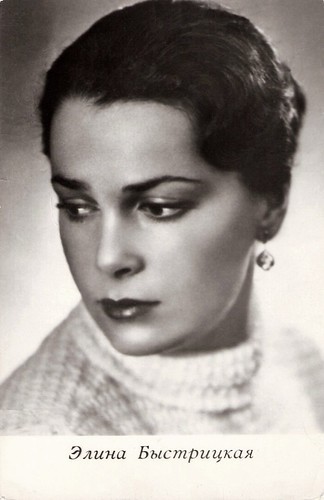
Russian postcard, 1966.
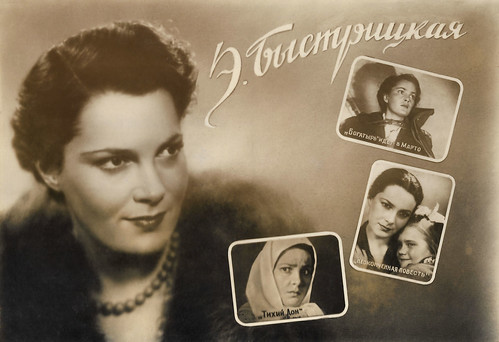
Russian multiview postcard, no. 115, 1958. Photos from above: Elina Bystritskaya in Bogatyr idyot v Marto/The bogatyr goes to Marto (Yevgeni Bryunchugin, Sigizmund Navrotsky, 1954), Neokonchennaya povest/Unfinished Story (Fridrikh Ermler, 1955) and Tikhiy Don/Quiet Flows the Don (Sergei Gerasimov, 1957).
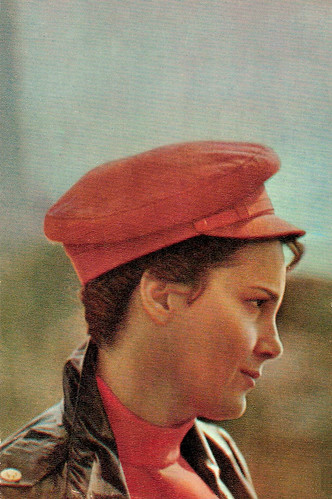
Russian postcard.
Socialist Realist Film
Elina Avraamovna Bystritskaya was born in 1928 in Kiev, Soviet Union (now: Ukrain). She was born to a Jewish family. Her father, Avraam Petrovich Bystritsky, was a notable medical doctor in Kiev, and her mother, Esther Isaakovna, worked as a medical administrator.
Young Elina worked as a nurse helping her parents in a Soviet military hospital during World War II. She was decorated by the Soviet State for her contribution. She went on to study as a medical nurse at Nezhin Nursing School, specialising in gynecology. She went to work at a gynecological clinic.
At the same time Elina started being engaged in amateur performances. Shortly after becoming a nurse, Bystritskaya tried out for a Kiev acting school and failed. Disappointed, she decided to study to become a teacher, but then tried out for acting school again and was accepted. From 1948-1953 she attended the Kiev Theatrical Institute.
In 1953 Elina Bystritskaya graduated from the institute and started working at the Russian Drama Theater in Vilnius (1953-1956), and then at the Moscow A.S. Pushkin Drama Theater (1956-1958).
From 1950 on, she acted in films, and quickly rose to fame. In 1955, she appeared with the later director Sergei Bondarchuk in Neokonchennaya povest/Unfinished Story (Fridrikh Ermler, 1955) an archetypal Socialist Realist film. With her role as a doctor in this film, she became a star in the Soviet Union.
Bystritskaya was acclaimed as the Best Soviet actress of the year, and was a member of the Soviet delegation in Paris for the Week of Soviet Film there.
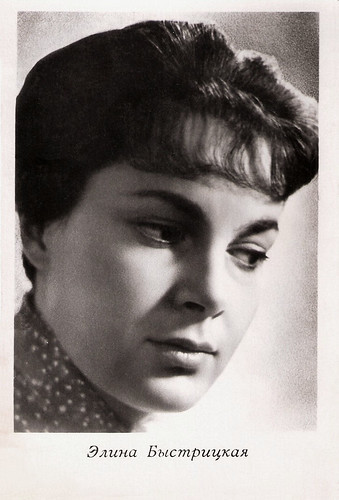
Russian postcard by Izdanije Byuro Propogandy Sovietskogo Kinoiskusstva, no. 3975, 1962. Retail price: 8 kop.
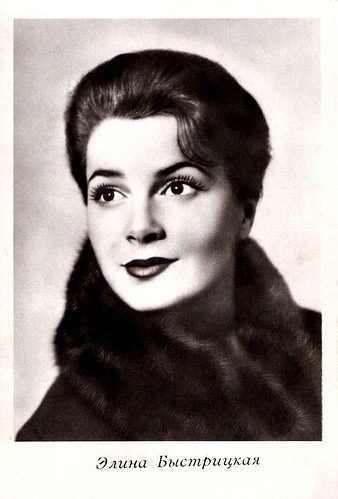
Russian postcard by Izdanije Byuro Propogandy Sovietskogo Kinoiskusstva, no. 4490, 1964. Retail price: 8 kop.
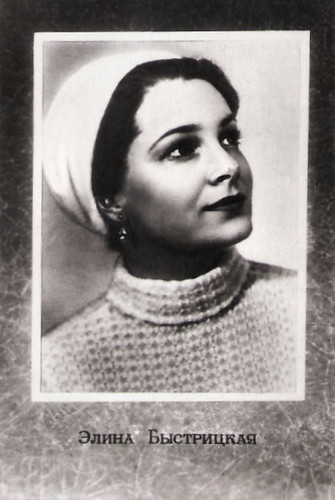
Small Russian collectors card.
The Russian equivalent of Gone with the Wind
In 1956, Elina Bystritskaya was handpicked by writer Mikhail Alexandrovich Sholokhov to co-star as Aksinya opposite Pyotr Glebov in the trilogy Tikhiy Don/And Quiet Flows the Don (Sergei Gerasimov, 1957-1958).
The three-part, 330 minutes lasting, epic film was released in 1957 (parts 1 and 2) and 1958 (part 3). It was based on Sholokhov's classic novel about a Cossack family living along the Don river, and portrays their experience of World War One, the Russian Revolution, and the Russian Civil War.
Proud and red-blooded Don Cossack Grigori (Pyotr Glebov) comes home from the First World War and has a crush on dark-haired Aksinya, but she is already married - an unhappy marriage. Angered by the adulterous affair, Grigori's parents arrange a marriage with a village bride, but even after being married, Grigori cannot stop seeing Aksinya.
The tragedy is set against a background of great historic upheaval, including big battle scenes: the First World War, the Revolution and the Civil War, making it the Russian equivalent of Gone with the Wind.
In 1958, Bystritskaya turned to theatre work in the Maly Theatre in Moscow, and her screen appearances grew sporadic. Her later films include Vsyo ostayotsya lyudyam/Everything Remains for the People (Georgi Natanson, 1963), and Bravye parni (Nikolai Zaseyev, 1993).
In 1960, the USSR sent a delegation to meet with President Eisenhower in the White House. Bystritskaya, along with Sergei Bondarchuk and Nikolay Cherkasov, was a member of that delegation. Bystritskaya was sought after by American directors, who wanted to invite the Soviet star to perform in Hollywood films. But she was not told of those offers, and she continued to perform solely in the Soviet Union.
In 1978 she was named People's Artist of the Year. She also taught acting at the Shchepkin school (Shchepkin Theatre School), and at the Soviet State Theatrical Institute (GITIS). At the age of 80 the actress still worked in the Maly Theatre.
Bystritska was married to Nicolas Kuzminsky, a member of the ministry of Foreign Affairs. The couple never had children. After she left acting, Bystritskaya remained in the public eye due to her political activism and her support for President Putin.
In 2014, Bystritskaya publicly opposed the 'Euromaidan' movement which was sweeping across Ukraine. The actress called on Ukrainian president Viktor Yanukovich to end the Euromaidan and arrest its participants. She and her fellow anti-Euromaidan protesters claimed that the Euromaidan movement was anti-Russian and called on Yanukovich to take action against the group’s leaders. That year, the Russian government annexed the Crimean Peninsula. The move sharply divided sentiments throughout the former Soviet Union. Bystritskaya was among those who supported the move.
On 26 April 2019, after a long illness, Elina Bystritskaya passed away in Moscow at the age of 91.

Small Romanian collectors card.
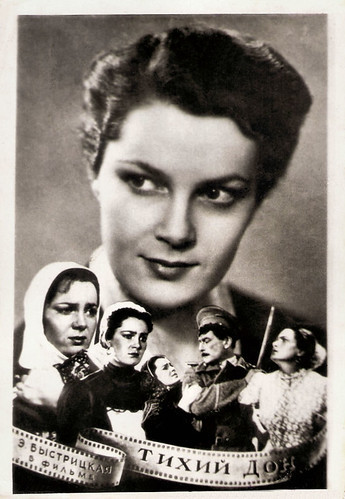
Russian multi-view card. Photo: combination of publicity stills for Tikhiy Don/And Quiet Flows the Don (Aleksandr Gerasimov, 1957).
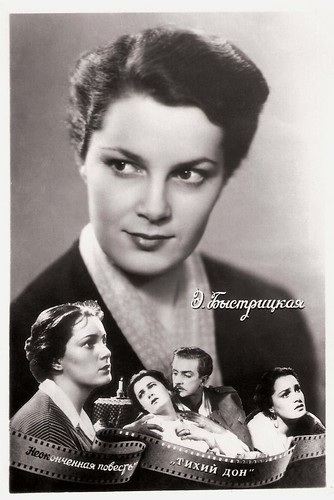
Russian postcard, no. A 506112. Price: 75 Kop. Released in an edition of 40,000 postcards.
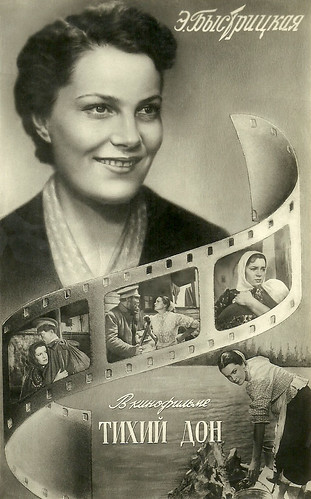
Russian postcard. Photo: compilation with still from Tikhiy Don/And Quiet Flows the Don (1957).
Love scenes from Tikhiy Don/And Quiet Flows the Don (1957-1958). Source: Elfiya (YouTube).
Sources: Kate Prengel (heavy.), (IMDb), Russia-IC, Wikipedia, and .

Russian postcard, 1966.

Russian multiview postcard, no. 115, 1958. Photos from above: Elina Bystritskaya in Bogatyr idyot v Marto/The bogatyr goes to Marto (Yevgeni Bryunchugin, Sigizmund Navrotsky, 1954), Neokonchennaya povest/Unfinished Story (Fridrikh Ermler, 1955) and Tikhiy Don/Quiet Flows the Don (Sergei Gerasimov, 1957).

Russian postcard.
Socialist Realist Film
Elina Avraamovna Bystritskaya was born in 1928 in Kiev, Soviet Union (now: Ukrain). She was born to a Jewish family. Her father, Avraam Petrovich Bystritsky, was a notable medical doctor in Kiev, and her mother, Esther Isaakovna, worked as a medical administrator.
Young Elina worked as a nurse helping her parents in a Soviet military hospital during World War II. She was decorated by the Soviet State for her contribution. She went on to study as a medical nurse at Nezhin Nursing School, specialising in gynecology. She went to work at a gynecological clinic.
At the same time Elina started being engaged in amateur performances. Shortly after becoming a nurse, Bystritskaya tried out for a Kiev acting school and failed. Disappointed, she decided to study to become a teacher, but then tried out for acting school again and was accepted. From 1948-1953 she attended the Kiev Theatrical Institute.
In 1953 Elina Bystritskaya graduated from the institute and started working at the Russian Drama Theater in Vilnius (1953-1956), and then at the Moscow A.S. Pushkin Drama Theater (1956-1958).
From 1950 on, she acted in films, and quickly rose to fame. In 1955, she appeared with the later director Sergei Bondarchuk in Neokonchennaya povest/Unfinished Story (Fridrikh Ermler, 1955) an archetypal Socialist Realist film. With her role as a doctor in this film, she became a star in the Soviet Union.
Bystritskaya was acclaimed as the Best Soviet actress of the year, and was a member of the Soviet delegation in Paris for the Week of Soviet Film there.

Russian postcard by Izdanije Byuro Propogandy Sovietskogo Kinoiskusstva, no. 3975, 1962. Retail price: 8 kop.

Russian postcard by Izdanije Byuro Propogandy Sovietskogo Kinoiskusstva, no. 4490, 1964. Retail price: 8 kop.

Small Russian collectors card.
The Russian equivalent of Gone with the Wind
In 1956, Elina Bystritskaya was handpicked by writer Mikhail Alexandrovich Sholokhov to co-star as Aksinya opposite Pyotr Glebov in the trilogy Tikhiy Don/And Quiet Flows the Don (Sergei Gerasimov, 1957-1958).
The three-part, 330 minutes lasting, epic film was released in 1957 (parts 1 and 2) and 1958 (part 3). It was based on Sholokhov's classic novel about a Cossack family living along the Don river, and portrays their experience of World War One, the Russian Revolution, and the Russian Civil War.
Proud and red-blooded Don Cossack Grigori (Pyotr Glebov) comes home from the First World War and has a crush on dark-haired Aksinya, but she is already married - an unhappy marriage. Angered by the adulterous affair, Grigori's parents arrange a marriage with a village bride, but even after being married, Grigori cannot stop seeing Aksinya.
The tragedy is set against a background of great historic upheaval, including big battle scenes: the First World War, the Revolution and the Civil War, making it the Russian equivalent of Gone with the Wind.
In 1958, Bystritskaya turned to theatre work in the Maly Theatre in Moscow, and her screen appearances grew sporadic. Her later films include Vsyo ostayotsya lyudyam/Everything Remains for the People (Georgi Natanson, 1963), and Bravye parni (Nikolai Zaseyev, 1993).
In 1960, the USSR sent a delegation to meet with President Eisenhower in the White House. Bystritskaya, along with Sergei Bondarchuk and Nikolay Cherkasov, was a member of that delegation. Bystritskaya was sought after by American directors, who wanted to invite the Soviet star to perform in Hollywood films. But she was not told of those offers, and she continued to perform solely in the Soviet Union.
In 1978 she was named People's Artist of the Year. She also taught acting at the Shchepkin school (Shchepkin Theatre School), and at the Soviet State Theatrical Institute (GITIS). At the age of 80 the actress still worked in the Maly Theatre.
Bystritska was married to Nicolas Kuzminsky, a member of the ministry of Foreign Affairs. The couple never had children. After she left acting, Bystritskaya remained in the public eye due to her political activism and her support for President Putin.
In 2014, Bystritskaya publicly opposed the 'Euromaidan' movement which was sweeping across Ukraine. The actress called on Ukrainian president Viktor Yanukovich to end the Euromaidan and arrest its participants. She and her fellow anti-Euromaidan protesters claimed that the Euromaidan movement was anti-Russian and called on Yanukovich to take action against the group’s leaders. That year, the Russian government annexed the Crimean Peninsula. The move sharply divided sentiments throughout the former Soviet Union. Bystritskaya was among those who supported the move.
On 26 April 2019, after a long illness, Elina Bystritskaya passed away in Moscow at the age of 91.

Small Romanian collectors card.

Russian multi-view card. Photo: combination of publicity stills for Tikhiy Don/And Quiet Flows the Don (Aleksandr Gerasimov, 1957).

Russian postcard, no. A 506112. Price: 75 Kop. Released in an edition of 40,000 postcards.

Russian postcard. Photo: compilation with still from Tikhiy Don/And Quiet Flows the Don (1957).
Love scenes from Tikhiy Don/And Quiet Flows the Don (1957-1958). Source: Elfiya (YouTube).
Sources: Kate Prengel (heavy.), (IMDb), Russia-IC, Wikipedia, and .
Published on April 26, 2019 13:33
April 25, 2019
Hannelore Elsner (1942-2019)
Earlier this week, on 21 April 2019, grand German actress Hannelore Elsner (1942-2019) died from cancer. Elsner started her film career in quickly forgotten light entertainment films, but in later years she starred in films by interesting directors like Edgar Reitz, István Szabó, Dani Levy and Uli Edel. She is best known in Germany for her roles in popular TV series such as Die Schwarzwaldklinik/The Black Forest Hospital (1987-1988) and the Krimi series Die Kommissarin/The Inspectoress (1994-2006).
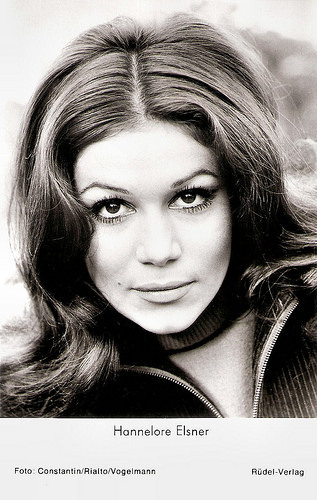
German postcard by Franz Josef Rüdel, Filmpostkartenverlag, Hamburg. Photo: Constantin / Rialto / Vogelmann. Publicity still for Zum Teufel mit der Penne - Die Lümmel von der ersten Bank, 2. Teil/To hell with the pen - The clown of the first bank, Part 2 (Werner Jacobs, 1968).
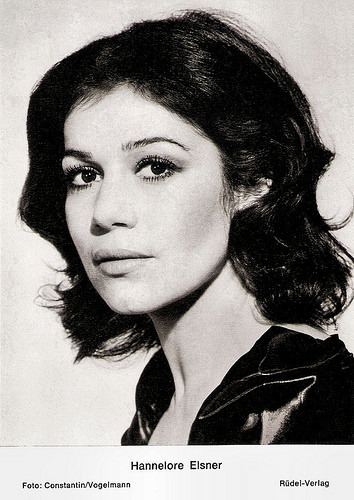
German postcard by Franz Josef Rüdel, Filmpostkartenverlag, Hamburg. Photo: Constantin / Vogelmann. Publicity still for ...aber Jonny!/...But Johnny! (Alfred Weidenmann, 1973).
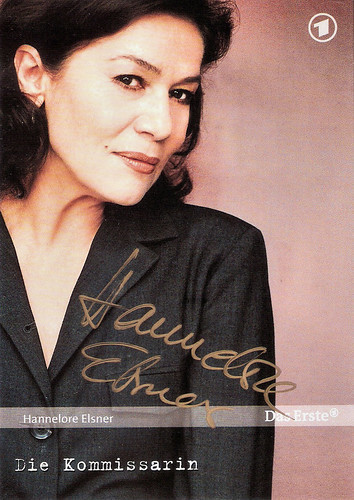
German postcard by Das Erste. Photo: ARD / Thorsten Eichhorst. Hannelore Elsner in the TV series Die Kommissarin/The Inspectoress (1994-2006).
Heimat
Hannelore Elsner was born Hannelore Elstner in 1942 in Burghausen, Bavaria. Her father, an engineer, died when she was eight years old. She lost her brother, who was three years older, during a World War II air raid.
In 1959, she made her screen debut in the Heimatfilm Alt Heidelberg/Old Heidelberg (Ernst Marischka, 1959) starring Christian Wolff . That year she also played small parts in Immer die Mädchen/Always the girls (Fritz Rémond Jr., 1959), with Hans-Joachim Kulenkampff, and Freddy unter fremden Sternen/Freddy under foreign stars (Wolfgang Schleif, 1959), featuring Schlager singer Freddy Quinn.
She had her first starring role in Das Mädchen mit den schmalen Hüften/Yusha (Johannes Kai, 1961) opposite Claus Wilcke . After finishing drama school in her hometown Burghausen in 1962, she worked in theatres in Berlin and München.
During the 1960s she continued to play in several light entertainment films, including the comedy Zur Hölle mit den Paukern/To hell with the drummers (Werner Jacobs, 1968). It was the first entry into the seven part Die Lümmel von der ersten Bank/The clown of the first bank series of comedy films starring Hansi Kraus and Theo Lingen . Elsner also appeared in the sports comedy Willi wird das Kind schon schaukeln/Willi Manages The Whole Thing (Werner Jacobs, 1972). It was the final entry into a four film series with Heinz Erhardt as Willi.
She also played in more serious films like Die Reise nach Wien/Trip to Vienna (Edgar Reitz, 1973), in which she co-starred with Elke Sommer and Mario Adorf . During the closing months of the Second World War, two small-town German women discover some money in an attic and decide to spend it on a trip to Vienna. Interesting was also the Italian adventure film Il ritorno di Zanna Bianca/Challenge to White Fang (Lucio Fulci, 1974) starring Franco Nero . It is the only official sequel to the box office hit Zanna Bianca/White Fang (Lucio Fulci, 1973).
From then on, she appeared in arthouse films like Berlinger (Alf Brustellin, Bernhard Sinkel, 1975), featuring Martin Benrath, the comedy Bomber & Paganini (Nicos Perakis, 1976) with Mario Adorf , and Grete Minde (Heidi Genée, 1977), based on the novel by Theodor Fontane and featuring Katerina Jacob.
For Der Schneider von Ulm/The Tailor from Ulm (1979), she reunited with director Edgar Reitz, who became famous for his TV series Heimat, in which Elsner also had a role. Der Schneider von Ulm tells the true story of a German pioneer aviator, Albrecht Berblinger (Tilo Prückner), in the late 18th century.
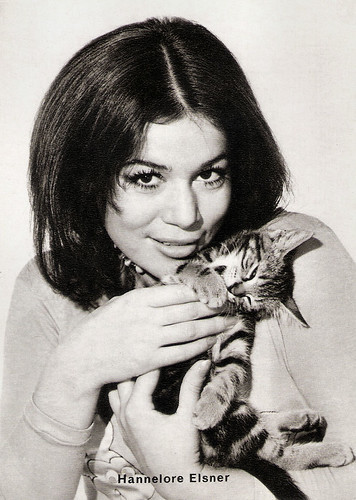
German postcard by Franz Josef Rüdel, Filmpostkartenverlag, Hamburg, no. 5194. Photo: Constantin / Rialto / Vogelmann. Hannelore Elsner in Hurra, wir sind mal wieder Junggesellen!/Hurray, we're bachelors again! (Harald Philipp, 1971).
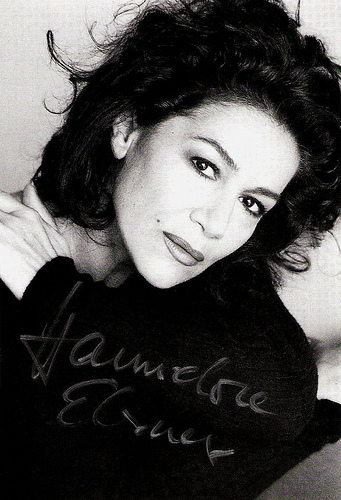
German autograph card. Photo: Ruth Kappus.
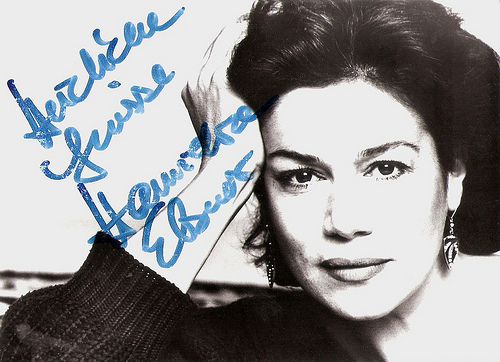
German postcard by Franz Josef Rüdel, Hamburg. Photo: Karin Rocholl, Hamburg.
First Krimi with a Female Lead
During the 1980s and 1990s, Hannelore Elsner starred in several films but also in many popular TV series such as Die Schwarzwaldklinik/The Black Forest Hospital (1987-1988). In 1980, she starred in the cold-war melodrama Der grüne Vogel/The green bird (1980) by acclaimed director István Szabó.
Her other films included the Swiss drama Mann ohne Gedächtnis/Man Without Memory (Kurt Gloor, 1984), the drama Marie Ward - Zwischen Galgen und Glorie/Marie Ward: Between gallows and glory (Angelika Weber, 1985), and the British crime film Parker (Jim Goddard, 1985) starring Bryan Brown.
She became well known in Germany and other German speaking countries for her role in the German detective series Die Kommissarin/The Inspectoress (1994-2006). The series, which takes place in Frankfurt am Main, Germany, is notable as being the first, and as one of the most successful, Krimi series with a female lead character. She played the lead character Inspector Lea Sommer in 66 episodes. Sommer is divorced with custody of her teenage son, Daniel. She is looking forward to a new relationship with her new boyfriend, Jonathan. Although Lea and Jonathan telephone each other frequently, he is never seen or heard on screen. Sommer was originally paired with Nick Siegel ( Til Schweiger ), but in a 1996 episode, Siegel was shot to death by an escaping criminal.
Elsner’s later films include Die Unberührbare/No Place to Go (Oskar Roehler, 2000) with Vadim Glowna, and Alles auf Zucker!/Go for Zucker (Dani Levy, 2004). This ironic comedy about modern Jewish identity in present-day Germany can be seen as part of the ´Ossi-Wessi´ confrontation within Germany. Henry Hübchen stars as Jaecki Zucker, and Elsner co-stars as his mother.
She then co-starred in the drama Kirschblüten – Hanami/Cherry Blossoms (Doris Dörrie, 2008), which tells the story of Rudi (Elmar Wepper): terminally ill, he travels to Japan after the sudden death of his wife Trudi (Elsner) – in order to make up for missed opportunities in life. Elsner also played German rapper Bushido’s mother in the biographical film Zeiten ändern dich/Times change you (Uli Edel, 2008), starring Bushido himself. Recently, she appeared in Hin und weg/Tour de Force (Christian Zübert, 2014), a powerful drama about euthanasia starring Florian David Fitz, and Hannas schlafende Hunde/Hanna’s sleeping dogs (Andreas Gruber, 2016).
Hannelore Elsner’s longtime companion was Professor Günter Blamberger. She was previously married to actor Gerd Vespermann (1964-1966) and Uwe Carstensen (1993-2000). She had a son, Dominik (1981), from a relationship with director Dieter Wedel.
Trailer Die endlose Nacht - Nebel über Tempelhof (1963). Source: Arild Rafalzik (YouTube).
Trailer for Il ritorno di Zanna Bianca/Challenge to White Fang (1974). Source: Italo-Cinema Trailer (YouTube).
German trailer for Auf das Leben/To Life! (2014). Source: Berlin & Beyond Film Festival (YouTube).
German trailer for Hannas schlafende Hunde/Hanna’s sleeping dogs (2016). Source: Vipmagazin (YouTube).
Sources: Wikipedia, and .

German postcard by Franz Josef Rüdel, Filmpostkartenverlag, Hamburg. Photo: Constantin / Rialto / Vogelmann. Publicity still for Zum Teufel mit der Penne - Die Lümmel von der ersten Bank, 2. Teil/To hell with the pen - The clown of the first bank, Part 2 (Werner Jacobs, 1968).

German postcard by Franz Josef Rüdel, Filmpostkartenverlag, Hamburg. Photo: Constantin / Vogelmann. Publicity still for ...aber Jonny!/...But Johnny! (Alfred Weidenmann, 1973).

German postcard by Das Erste. Photo: ARD / Thorsten Eichhorst. Hannelore Elsner in the TV series Die Kommissarin/The Inspectoress (1994-2006).
Heimat
Hannelore Elsner was born Hannelore Elstner in 1942 in Burghausen, Bavaria. Her father, an engineer, died when she was eight years old. She lost her brother, who was three years older, during a World War II air raid.
In 1959, she made her screen debut in the Heimatfilm Alt Heidelberg/Old Heidelberg (Ernst Marischka, 1959) starring Christian Wolff . That year she also played small parts in Immer die Mädchen/Always the girls (Fritz Rémond Jr., 1959), with Hans-Joachim Kulenkampff, and Freddy unter fremden Sternen/Freddy under foreign stars (Wolfgang Schleif, 1959), featuring Schlager singer Freddy Quinn.
She had her first starring role in Das Mädchen mit den schmalen Hüften/Yusha (Johannes Kai, 1961) opposite Claus Wilcke . After finishing drama school in her hometown Burghausen in 1962, she worked in theatres in Berlin and München.
During the 1960s she continued to play in several light entertainment films, including the comedy Zur Hölle mit den Paukern/To hell with the drummers (Werner Jacobs, 1968). It was the first entry into the seven part Die Lümmel von der ersten Bank/The clown of the first bank series of comedy films starring Hansi Kraus and Theo Lingen . Elsner also appeared in the sports comedy Willi wird das Kind schon schaukeln/Willi Manages The Whole Thing (Werner Jacobs, 1972). It was the final entry into a four film series with Heinz Erhardt as Willi.
She also played in more serious films like Die Reise nach Wien/Trip to Vienna (Edgar Reitz, 1973), in which she co-starred with Elke Sommer and Mario Adorf . During the closing months of the Second World War, two small-town German women discover some money in an attic and decide to spend it on a trip to Vienna. Interesting was also the Italian adventure film Il ritorno di Zanna Bianca/Challenge to White Fang (Lucio Fulci, 1974) starring Franco Nero . It is the only official sequel to the box office hit Zanna Bianca/White Fang (Lucio Fulci, 1973).
From then on, she appeared in arthouse films like Berlinger (Alf Brustellin, Bernhard Sinkel, 1975), featuring Martin Benrath, the comedy Bomber & Paganini (Nicos Perakis, 1976) with Mario Adorf , and Grete Minde (Heidi Genée, 1977), based on the novel by Theodor Fontane and featuring Katerina Jacob.
For Der Schneider von Ulm/The Tailor from Ulm (1979), she reunited with director Edgar Reitz, who became famous for his TV series Heimat, in which Elsner also had a role. Der Schneider von Ulm tells the true story of a German pioneer aviator, Albrecht Berblinger (Tilo Prückner), in the late 18th century.

German postcard by Franz Josef Rüdel, Filmpostkartenverlag, Hamburg, no. 5194. Photo: Constantin / Rialto / Vogelmann. Hannelore Elsner in Hurra, wir sind mal wieder Junggesellen!/Hurray, we're bachelors again! (Harald Philipp, 1971).

German autograph card. Photo: Ruth Kappus.

German postcard by Franz Josef Rüdel, Hamburg. Photo: Karin Rocholl, Hamburg.
First Krimi with a Female Lead
During the 1980s and 1990s, Hannelore Elsner starred in several films but also in many popular TV series such as Die Schwarzwaldklinik/The Black Forest Hospital (1987-1988). In 1980, she starred in the cold-war melodrama Der grüne Vogel/The green bird (1980) by acclaimed director István Szabó.
Her other films included the Swiss drama Mann ohne Gedächtnis/Man Without Memory (Kurt Gloor, 1984), the drama Marie Ward - Zwischen Galgen und Glorie/Marie Ward: Between gallows and glory (Angelika Weber, 1985), and the British crime film Parker (Jim Goddard, 1985) starring Bryan Brown.
She became well known in Germany and other German speaking countries for her role in the German detective series Die Kommissarin/The Inspectoress (1994-2006). The series, which takes place in Frankfurt am Main, Germany, is notable as being the first, and as one of the most successful, Krimi series with a female lead character. She played the lead character Inspector Lea Sommer in 66 episodes. Sommer is divorced with custody of her teenage son, Daniel. She is looking forward to a new relationship with her new boyfriend, Jonathan. Although Lea and Jonathan telephone each other frequently, he is never seen or heard on screen. Sommer was originally paired with Nick Siegel ( Til Schweiger ), but in a 1996 episode, Siegel was shot to death by an escaping criminal.
Elsner’s later films include Die Unberührbare/No Place to Go (Oskar Roehler, 2000) with Vadim Glowna, and Alles auf Zucker!/Go for Zucker (Dani Levy, 2004). This ironic comedy about modern Jewish identity in present-day Germany can be seen as part of the ´Ossi-Wessi´ confrontation within Germany. Henry Hübchen stars as Jaecki Zucker, and Elsner co-stars as his mother.
She then co-starred in the drama Kirschblüten – Hanami/Cherry Blossoms (Doris Dörrie, 2008), which tells the story of Rudi (Elmar Wepper): terminally ill, he travels to Japan after the sudden death of his wife Trudi (Elsner) – in order to make up for missed opportunities in life. Elsner also played German rapper Bushido’s mother in the biographical film Zeiten ändern dich/Times change you (Uli Edel, 2008), starring Bushido himself. Recently, she appeared in Hin und weg/Tour de Force (Christian Zübert, 2014), a powerful drama about euthanasia starring Florian David Fitz, and Hannas schlafende Hunde/Hanna’s sleeping dogs (Andreas Gruber, 2016).
Hannelore Elsner’s longtime companion was Professor Günter Blamberger. She was previously married to actor Gerd Vespermann (1964-1966) and Uwe Carstensen (1993-2000). She had a son, Dominik (1981), from a relationship with director Dieter Wedel.
Trailer Die endlose Nacht - Nebel über Tempelhof (1963). Source: Arild Rafalzik (YouTube).
Trailer for Il ritorno di Zanna Bianca/Challenge to White Fang (1974). Source: Italo-Cinema Trailer (YouTube).
German trailer for Auf das Leben/To Life! (2014). Source: Berlin & Beyond Film Festival (YouTube).
German trailer for Hannas schlafende Hunde/Hanna’s sleeping dogs (2016). Source: Vipmagazin (YouTube).
Sources: Wikipedia, and .
Published on April 25, 2019 22:00
April 24, 2019
Dick Rivers
Yesterday, French singer and actor Dick Rivers (1945-2019) passed away. With Eddy Mitchell and Johnny Hallyday, he was one of the three stars who introduced Rock and Roll in France in the early 1960s. He was the frontman of the group Les Chats Sauvages. In later life, he also appeared in some films. Dick Rivers was 74.
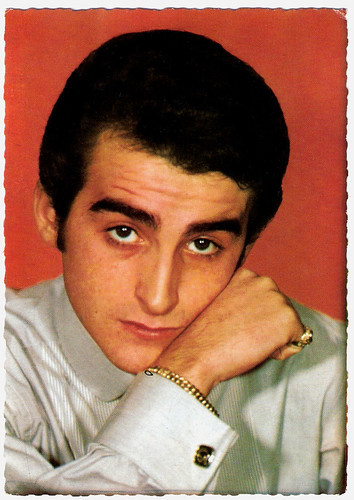
French postcard by PSG, no. 923. Photo: Patrick Bertrand.

Dutch postcard by 't Sticht, Utrecht, no. AX 6343.
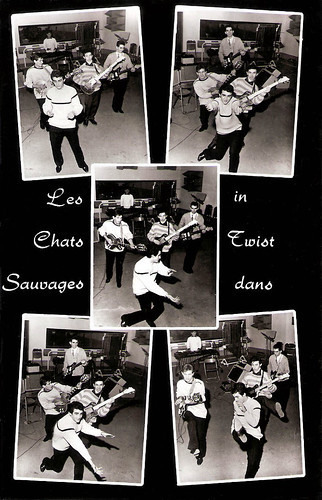
Dutch postcard by Hercules, Haarlem, no. 641. Caption: Les Chats Sauvages in Twist Dance.
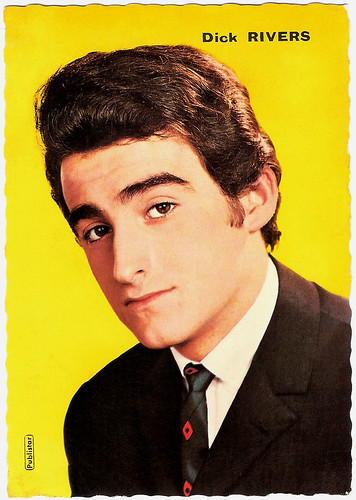
French collectors card by Publistar.
The Wild Cats
Dick Rivers was born Hervé Fornieri in in Villefranche-sur-Mer in southern France in 1945. He was fascinated by America, the juke box and Rock and Roll. He admired Elvis Presley, who highly influenced both his singing and his looks.
In 1960, at the age of fifteen, Hervé founded with three friends, guitarists Jean-Claude and Gerard Roboly, and bassist Gerard Jacquemus, the group Les Chats Sauvages (The Wild Cats). With his black hair slicked back, his never worn jeans and his cowboy boots he was the lead singer. His stage name came from the character (Deke Rivers) that Presley played in his second film, Loving You (Hal Kanter, 1957).
In February 1961, the British music magazine, NME , reported that Rivers concert at the Palais des Sports de Paris, whilst headlining with Vince Taylor , had turned into a full-scale riot. Between May 1961 and June 1962, he recorded with Les Chats Sauvages more than a hundred songs, and they sold more than 2 million albums.
Big hits were Ma petite amie est vache (My girlfriend is a cow), Twist à Saint-Tropez (Twist in Saint-Tropez) and Est-ce que tu le sais (Do you know). The band’s success extended to all French-speaking countries, Belgium, Switzerland and Quebec, where they attracted large crowds.
But then, Rivers suddenly left Les Chats Sauvages.
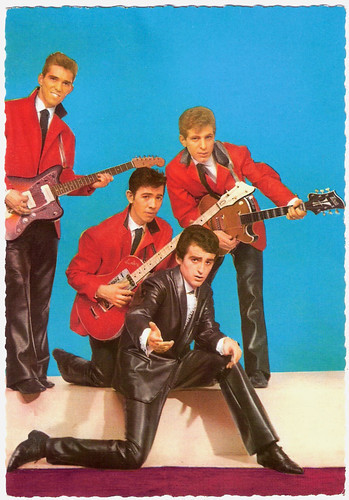
French postcard by E.D.U.G., no. 228. Photo: Sam Lévin .
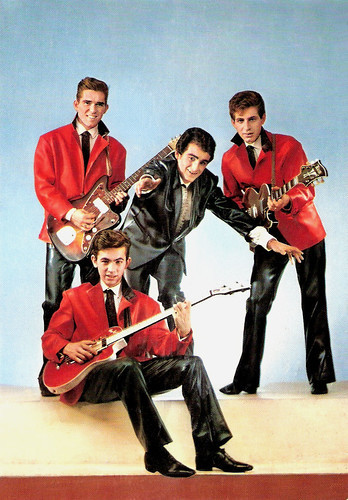
French postcard by Editions P.I., Paris, no. 1095. Photo: Sam Lévin .
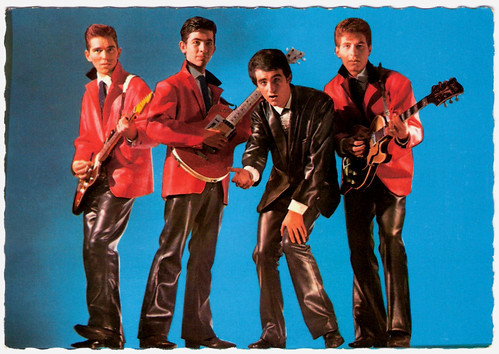
French postcard by E.D.U.G., no. 227. Photo: Sam Lévin .
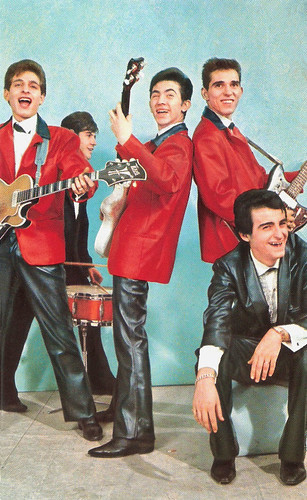
French postcard by P.I., no. 1085, offered by Corvisart. Photo: Jean Mainbourg.
Mister D
In September 1962, Dick Rivers released his solo single Baby John which sold 200,000 copies. It was the start of a long and successful solo career, with more than thirty albums (three in English) and many singles.
Among his hits were Tu n'es plus là (1963), the French version of Roy Orbison’s Blue Bayou, and Va t'en va t'en (1965), based on Go Now by the Moody Blues.
In the 1970s, his music seemed outdated. For ten years, between 1982 and 1992, he hosted a program devoted to rock on Radio Monte Carlo.
In 1994, a first collection of his old successes, Very-Dick was certified gold the following year. He started to record new music. In 1999, Dick made his first film La Candide Madame Duff/The Candid Lady Duff (Jean-Pierre Mocky, 1999) and gave about 60 concerts in France, Belgium and Switzerland.
In 2003, Rivers played in the comedy Le Furet/The Ferret (Jean-Pierre Mocky, 2003) with Jacques Villeret and Michel Serrault. The following year he appeared on stage in the play Les Paravents (The Screens) by Jean Genet, at the Théâtre National de Chaillot. It was a success.
Furthermore, he was the French voice of Shere Khan in Jungle Book 2 (Steve Trenbirth, 2003) and he also gave his voice to Arthur et les Minimoys/Arthur and the Invisibles (Luc Besson, 2006). On television he appeared in Mon amour de fantôme/Phantom Love (Arnaud Sélignac, 2007).
To celebrate his 50-year career, the album Mister D was released in 2011. At the same time, a book with the same title was published containing his memoirs collected by Sam Bernett. He returned to the stage and made a tour in France.
Dick Rivers passed away on 24 April 2019. He died of cancer and was 74. He was married to Micheline Davis, but they separated. They had a son, Pascal, and an adopted daughter, Natala, who lived for three years with the American director George Lucas. Later Rivers lived together with longtime partner Babette.

Small French collectors card, offered by Jony Biscuits.
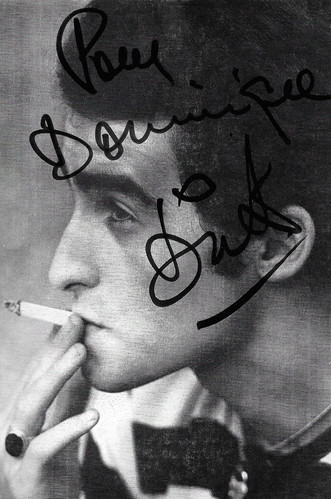
French promotion card by Pathé Marconi, no. 1-64. Photo: Pleine Page.
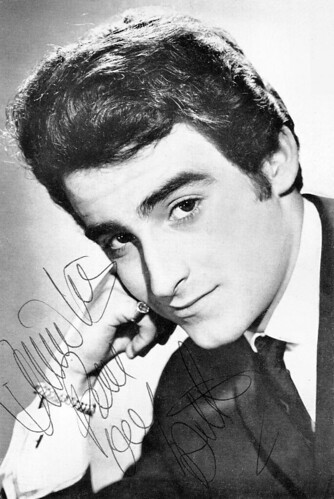
French promotion card by Pathé Marconi, no. 5-63. Photo: Vallois.
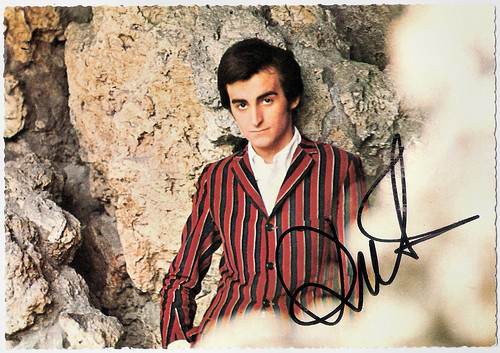
French postcard by Publistar, Marseille, no. 1339.
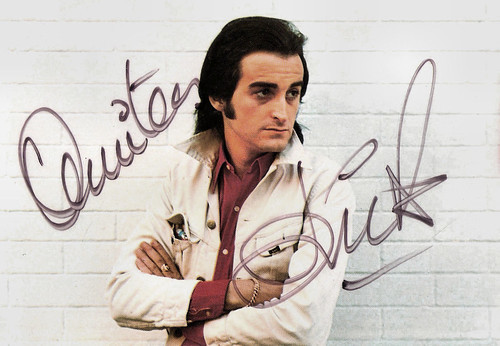
French promotion card by Sonopresse. Photo: Tony Frank.
Sources: RFI Musique (French), Dick Rivers.com (French), Wikipedia (French and English) and .

French postcard by PSG, no. 923. Photo: Patrick Bertrand.

Dutch postcard by 't Sticht, Utrecht, no. AX 6343.

Dutch postcard by Hercules, Haarlem, no. 641. Caption: Les Chats Sauvages in Twist Dance.

French collectors card by Publistar.
The Wild Cats
Dick Rivers was born Hervé Fornieri in in Villefranche-sur-Mer in southern France in 1945. He was fascinated by America, the juke box and Rock and Roll. He admired Elvis Presley, who highly influenced both his singing and his looks.
In 1960, at the age of fifteen, Hervé founded with three friends, guitarists Jean-Claude and Gerard Roboly, and bassist Gerard Jacquemus, the group Les Chats Sauvages (The Wild Cats). With his black hair slicked back, his never worn jeans and his cowboy boots he was the lead singer. His stage name came from the character (Deke Rivers) that Presley played in his second film, Loving You (Hal Kanter, 1957).
In February 1961, the British music magazine, NME , reported that Rivers concert at the Palais des Sports de Paris, whilst headlining with Vince Taylor , had turned into a full-scale riot. Between May 1961 and June 1962, he recorded with Les Chats Sauvages more than a hundred songs, and they sold more than 2 million albums.
Big hits were Ma petite amie est vache (My girlfriend is a cow), Twist à Saint-Tropez (Twist in Saint-Tropez) and Est-ce que tu le sais (Do you know). The band’s success extended to all French-speaking countries, Belgium, Switzerland and Quebec, where they attracted large crowds.
But then, Rivers suddenly left Les Chats Sauvages.

French postcard by E.D.U.G., no. 228. Photo: Sam Lévin .

French postcard by Editions P.I., Paris, no. 1095. Photo: Sam Lévin .

French postcard by E.D.U.G., no. 227. Photo: Sam Lévin .

French postcard by P.I., no. 1085, offered by Corvisart. Photo: Jean Mainbourg.
Mister D
In September 1962, Dick Rivers released his solo single Baby John which sold 200,000 copies. It was the start of a long and successful solo career, with more than thirty albums (three in English) and many singles.
Among his hits were Tu n'es plus là (1963), the French version of Roy Orbison’s Blue Bayou, and Va t'en va t'en (1965), based on Go Now by the Moody Blues.
In the 1970s, his music seemed outdated. For ten years, between 1982 and 1992, he hosted a program devoted to rock on Radio Monte Carlo.
In 1994, a first collection of his old successes, Very-Dick was certified gold the following year. He started to record new music. In 1999, Dick made his first film La Candide Madame Duff/The Candid Lady Duff (Jean-Pierre Mocky, 1999) and gave about 60 concerts in France, Belgium and Switzerland.
In 2003, Rivers played in the comedy Le Furet/The Ferret (Jean-Pierre Mocky, 2003) with Jacques Villeret and Michel Serrault. The following year he appeared on stage in the play Les Paravents (The Screens) by Jean Genet, at the Théâtre National de Chaillot. It was a success.
Furthermore, he was the French voice of Shere Khan in Jungle Book 2 (Steve Trenbirth, 2003) and he also gave his voice to Arthur et les Minimoys/Arthur and the Invisibles (Luc Besson, 2006). On television he appeared in Mon amour de fantôme/Phantom Love (Arnaud Sélignac, 2007).
To celebrate his 50-year career, the album Mister D was released in 2011. At the same time, a book with the same title was published containing his memoirs collected by Sam Bernett. He returned to the stage and made a tour in France.
Dick Rivers passed away on 24 April 2019. He died of cancer and was 74. He was married to Micheline Davis, but they separated. They had a son, Pascal, and an adopted daughter, Natala, who lived for three years with the American director George Lucas. Later Rivers lived together with longtime partner Babette.

Small French collectors card, offered by Jony Biscuits.

French promotion card by Pathé Marconi, no. 1-64. Photo: Pleine Page.

French promotion card by Pathé Marconi, no. 5-63. Photo: Vallois.

French postcard by Publistar, Marseille, no. 1339.

French promotion card by Sonopresse. Photo: Tony Frank.
Sources: RFI Musique (French), Dick Rivers.com (French), Wikipedia (French and English) and .
Published on April 24, 2019 22:00
April 23, 2019
Dama sa crnom krinkom (1918)
Last year, film historian Ivo Blom did an interesting find, a series of sepia postcards of three lost, silent films from the former Kingdom of Serbs, Croatians and Slovenes, now Croatia. The films were produced by the short-lived studio Croatia Film and distributed in 1919 by Jugoslavija Film in Zagreb. On 25 October 2018, EFSP did a post on the drama Dvije sirote/Dvije sirotice/The Two Orphans (Alfred Grinhut a.k.a. Alfred Grünhut, 1918). Today follows the second post, Dama sa crnom krinkom/The Lady in the Black Mask (Robert Staerk, 1918), starring Austrian actress Gina Klitsch in the title role.
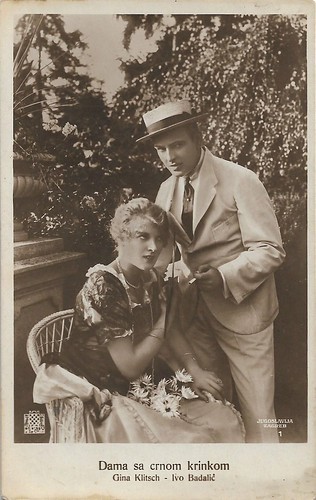
Yugoslavian postcard by Jugoslavija Film, Zagreb, no. 1. Photo: Croatia Film. Publicity still for Dama sa crnom krinkom/The Lady in the Black Mask (Robert Staerk, 1918) with Ivo Badallic and Gina Klitsch.
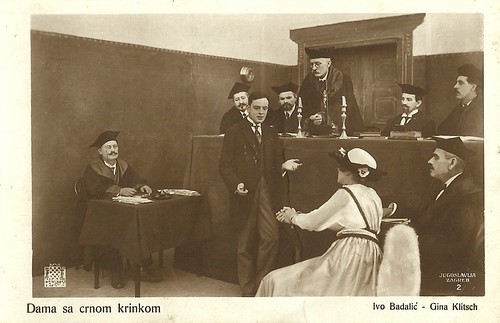
Yugoslavian postcard by Jugoslavija Film, Zagreb, no. 2. Photo: Croatia Film. Publicity still for Dama sa crnom krinkom/The Lady in the Black Mask (Robert Staerk, 1918) with Ivo Badallic and Gina Klitsch.
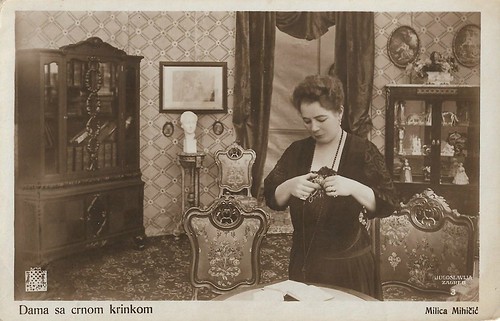
Yugoslavian postcard by Jugoslavija Film, Zagreb, no. 3. Photo: Croatia Film. Publicity still for Dama sa crnom krinkom/The Lady in the Black Mask (Robert Staerk, 1918) with Milica Mihicic.
A mundane melodrama unable to veil its technical shortcomings
Domestic film production in Croatia started during the First World War. In 1917, Hamilkar Bošković and Julien Bergmann founded the first Croatian film company, Croatia. They engaged Croatian actors and directors and Austrian technicians. At the end of 1918 Bošković and Bergmann sold their rights to the new company Hermes or New Croatia, which was active until 1920.
About their production Dama sa crnom krinkom/The Lady in the Black Mask (Robert Staerk, 1918), former film historian Peter Volk wrote that only photos and some notes were left. However, he condemned the film as pretending to display a mundane melodrama but not being able to veil its technical shortcomings. Therefore, Sreten Jovanovic, in his 1976 text Metodoloski pristup istoriji jugoslovenske kinematografije sa posebnim osvrtom na kinematografiju u Zagrebu 1917-1923, is rather critical of Volk's judgements. The film itself is still lost, so we cannot check the qualities for ourselves.
In 1917 a stage play came out at the London Haymarket theatre, called The Lady in the Black Mask, by Tom Gallon, whose last work this was before he died. Perhaps the film was based on it. The play begins in a theatre with the heroine, Ruth, watching a play. Arriving home from the theatre, Damia, the girl whose companion she is, pleads fatigue and persuades her to go out again to a masked ball, wearing the dress and indeed assuming the personality of her mistress. The two girls live in a gloomy house with old Mr. Verinder, who is Damia's guardian. But when Ruth returns from the ball, Verinder has been stabbed during Ruth's absence. As no one knows, or would ever believe, that it was Damia and not herself who had remained at home, Ruth is in a pretty bad situation. Moreover, it is not sure whether Damia really killed Verinder...
Little is known about director Robert Staerk. After Dama sa crnom krinkom/The Lady in the Black Mask, he returned to the film sets after a gap of a decade, to act instead of direct. Between 1928 and 1932 he acted in three German films.
Very little is also known about the actress Gina Klitsch, who played the lead in the film. She is named Tina Klitsch on IMDb, and it would have been her only film. However, there was an Austrian actress Gina Puch-Klitsch. She was the sister of Austrian film star Olaf Fjord , originally Ämilian Maximilian Pouch. Puch-Klitsch played in three Austrian films in 1920, produced by her brother's company Fjord-Film, and starring himself. In 1922 she was Empress Elisabeth (Sissi) in Ludwig II (Otto Kreisler, 1922), opposite her brother in the title role. In 1930 she had a major part opposite Oscar Marion and Attila Hörbiger in the Austrian film Die Tat des Andreas Harmer/The act of Andreas Harmer (Alfred Deutsch, 1930).
Milica Mihicic (1864–1950) was a Croatian actress known for her early part in Dama sa crnom krinkom (1918). As a pupil of the Croatian actor and director Mandrović, Mihicic debuted in 1890 at the Croatian National Theatre. She was accepted and worked over 50 years on this stage. She acted often in plays by such French authors as Ohnet, Bourdet, etc., whose characterts she was able to enliven with fine irony. She also appeared in the realistic and psychological plays by Tolstoy, Ibsen, Hauptmann, Pirandello etc. Mihicic was an important supporter of local plays by Vojnović, Begović (sd.), Krleža, Kulundžić, etc. She also translated some German and French plays into Croatian.
Ignjat (Ignacij) Borštnik (1858-1919) was a Croatian and Slovene actor. He scripted the first and very ambitious project of the new Yugoslavia, Brišem i sudim/B. and the Judges (Arnošt Grund, 1917), a grandiose, poetic melodrama. Borštnik interpreted the main role in the film as well. Tošo Lesić and Ivo Badalić, who also played in Dama sa crnom krinkom, acted in Brišem i sudim/B. and the judge as well. Tošo Lesić aka Teodor Lesić (1866-1949) was a Croatian actor.
Ivo Badalić (1890-1937) was a Croatian actor and director. He was a member of the Zagreb Drama Theatre, then worked in Split and Osijek. He participated in the first Croatian feature films, such as Brišem i sudim/B. and the Judges (Arnošt Grund, 1917), Matija Gubec (Aleksandar-Aca Binicki, 1917) and Dama sa crnom krinkom/The Lady in the Black Mask (Robert Staerk, 1918). In the theatre, he made significant acting achievements in plays by William Shakespeare and Miroslav Krleža.
NB. Dama sa crnom krinkom/The Lady in the Black Mask (Robert Staerk, 1918) was distributed by Jugoslavija Film in 1919, that's why IMDb lists it as a production from 1919.
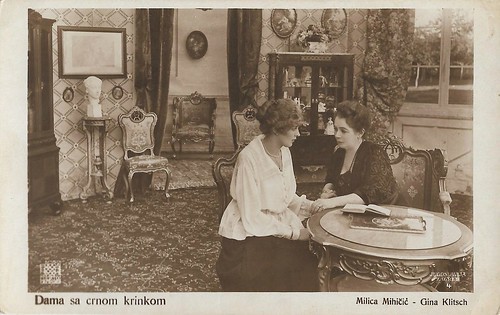
Yugoslavian postcard by Jugoslavija Film, Zagreb, no. 4. Photo: Croatia Film. Publicity still for Dama sa crnom krinkom/The Lady in the Black Mask (Robert Staerk, 1918) with Milica Mihicic and Gina Klitsch.
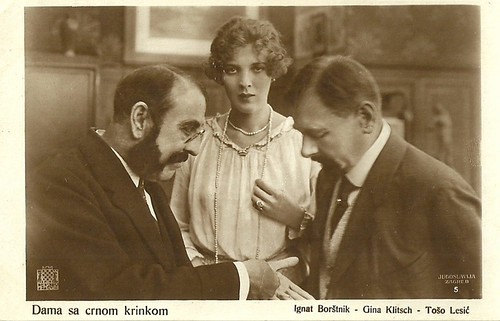
Yugoslavian postcard by Jugoslavija Film, Zagreb, no. 5. Photo: Croatia Film. Publicity still for Dama sa crnom krinkom/The Lady in the Black Mask (Robert Staerk, 1918) with Gina Klitsch, Ignat Borstnik and Toso Lesic.

Yugoslavian postcard by Jugoslavija Film, Zagreb, no. 6. Photo: Croatia Film. Publicity still for Dama sa crnom krinkom/The Lady in the Black Mask (Robert Staerk, 1918) with Gina Klitsch and Toso Lesic.
Sources: Biographien.ac.at, Wikipedia and IMDb.

Yugoslavian postcard by Jugoslavija Film, Zagreb, no. 1. Photo: Croatia Film. Publicity still for Dama sa crnom krinkom/The Lady in the Black Mask (Robert Staerk, 1918) with Ivo Badallic and Gina Klitsch.

Yugoslavian postcard by Jugoslavija Film, Zagreb, no. 2. Photo: Croatia Film. Publicity still for Dama sa crnom krinkom/The Lady in the Black Mask (Robert Staerk, 1918) with Ivo Badallic and Gina Klitsch.

Yugoslavian postcard by Jugoslavija Film, Zagreb, no. 3. Photo: Croatia Film. Publicity still for Dama sa crnom krinkom/The Lady in the Black Mask (Robert Staerk, 1918) with Milica Mihicic.
A mundane melodrama unable to veil its technical shortcomings
Domestic film production in Croatia started during the First World War. In 1917, Hamilkar Bošković and Julien Bergmann founded the first Croatian film company, Croatia. They engaged Croatian actors and directors and Austrian technicians. At the end of 1918 Bošković and Bergmann sold their rights to the new company Hermes or New Croatia, which was active until 1920.
About their production Dama sa crnom krinkom/The Lady in the Black Mask (Robert Staerk, 1918), former film historian Peter Volk wrote that only photos and some notes were left. However, he condemned the film as pretending to display a mundane melodrama but not being able to veil its technical shortcomings. Therefore, Sreten Jovanovic, in his 1976 text Metodoloski pristup istoriji jugoslovenske kinematografije sa posebnim osvrtom na kinematografiju u Zagrebu 1917-1923, is rather critical of Volk's judgements. The film itself is still lost, so we cannot check the qualities for ourselves.
In 1917 a stage play came out at the London Haymarket theatre, called The Lady in the Black Mask, by Tom Gallon, whose last work this was before he died. Perhaps the film was based on it. The play begins in a theatre with the heroine, Ruth, watching a play. Arriving home from the theatre, Damia, the girl whose companion she is, pleads fatigue and persuades her to go out again to a masked ball, wearing the dress and indeed assuming the personality of her mistress. The two girls live in a gloomy house with old Mr. Verinder, who is Damia's guardian. But when Ruth returns from the ball, Verinder has been stabbed during Ruth's absence. As no one knows, or would ever believe, that it was Damia and not herself who had remained at home, Ruth is in a pretty bad situation. Moreover, it is not sure whether Damia really killed Verinder...
Little is known about director Robert Staerk. After Dama sa crnom krinkom/The Lady in the Black Mask, he returned to the film sets after a gap of a decade, to act instead of direct. Between 1928 and 1932 he acted in three German films.
Very little is also known about the actress Gina Klitsch, who played the lead in the film. She is named Tina Klitsch on IMDb, and it would have been her only film. However, there was an Austrian actress Gina Puch-Klitsch. She was the sister of Austrian film star Olaf Fjord , originally Ämilian Maximilian Pouch. Puch-Klitsch played in three Austrian films in 1920, produced by her brother's company Fjord-Film, and starring himself. In 1922 she was Empress Elisabeth (Sissi) in Ludwig II (Otto Kreisler, 1922), opposite her brother in the title role. In 1930 she had a major part opposite Oscar Marion and Attila Hörbiger in the Austrian film Die Tat des Andreas Harmer/The act of Andreas Harmer (Alfred Deutsch, 1930).
Milica Mihicic (1864–1950) was a Croatian actress known for her early part in Dama sa crnom krinkom (1918). As a pupil of the Croatian actor and director Mandrović, Mihicic debuted in 1890 at the Croatian National Theatre. She was accepted and worked over 50 years on this stage. She acted often in plays by such French authors as Ohnet, Bourdet, etc., whose characterts she was able to enliven with fine irony. She also appeared in the realistic and psychological plays by Tolstoy, Ibsen, Hauptmann, Pirandello etc. Mihicic was an important supporter of local plays by Vojnović, Begović (sd.), Krleža, Kulundžić, etc. She also translated some German and French plays into Croatian.
Ignjat (Ignacij) Borštnik (1858-1919) was a Croatian and Slovene actor. He scripted the first and very ambitious project of the new Yugoslavia, Brišem i sudim/B. and the Judges (Arnošt Grund, 1917), a grandiose, poetic melodrama. Borštnik interpreted the main role in the film as well. Tošo Lesić and Ivo Badalić, who also played in Dama sa crnom krinkom, acted in Brišem i sudim/B. and the judge as well. Tošo Lesić aka Teodor Lesić (1866-1949) was a Croatian actor.
Ivo Badalić (1890-1937) was a Croatian actor and director. He was a member of the Zagreb Drama Theatre, then worked in Split and Osijek. He participated in the first Croatian feature films, such as Brišem i sudim/B. and the Judges (Arnošt Grund, 1917), Matija Gubec (Aleksandar-Aca Binicki, 1917) and Dama sa crnom krinkom/The Lady in the Black Mask (Robert Staerk, 1918). In the theatre, he made significant acting achievements in plays by William Shakespeare and Miroslav Krleža.
NB. Dama sa crnom krinkom/The Lady in the Black Mask (Robert Staerk, 1918) was distributed by Jugoslavija Film in 1919, that's why IMDb lists it as a production from 1919.

Yugoslavian postcard by Jugoslavija Film, Zagreb, no. 4. Photo: Croatia Film. Publicity still for Dama sa crnom krinkom/The Lady in the Black Mask (Robert Staerk, 1918) with Milica Mihicic and Gina Klitsch.

Yugoslavian postcard by Jugoslavija Film, Zagreb, no. 5. Photo: Croatia Film. Publicity still for Dama sa crnom krinkom/The Lady in the Black Mask (Robert Staerk, 1918) with Gina Klitsch, Ignat Borstnik and Toso Lesic.

Yugoslavian postcard by Jugoslavija Film, Zagreb, no. 6. Photo: Croatia Film. Publicity still for Dama sa crnom krinkom/The Lady in the Black Mask (Robert Staerk, 1918) with Gina Klitsch and Toso Lesic.
Sources: Biographien.ac.at, Wikipedia and IMDb.
Published on April 23, 2019 22:00
April 22, 2019
Violantha (1927)
Henny Porten played the title role as a simple and natural mountain girl in the German silent drama Violantha (Carl Froehlich, 1927), which is situated in the Swiss Alps. Again Henny's happiness is in danger because of secrets from the past. The later director Wilhelm (William) Dieterle was her co-star. The film was produced by Porten's own film company, which she managed together with director Carl Froelich, and by the Swiss company Monopol-Film.
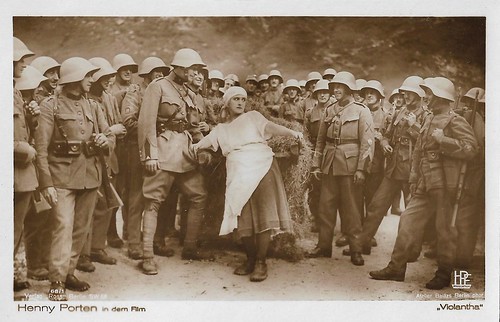
German postcard by Ross Verlag, no. 68/1. Photo: Atelier Balázs, Berlin / Henny Porten-Film. Publicity still for Violantha (Carl Froehlich, 1927) with Henny Porten .
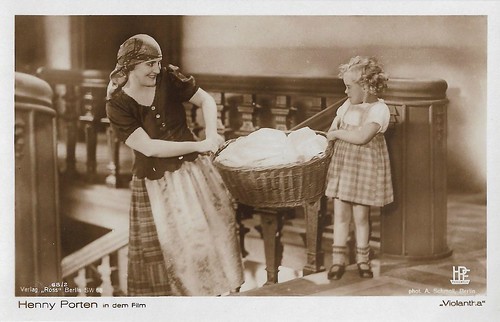
German postcard by Ross Verlag, no. 68/2. Photo: A. Schmoll, Berlin / Henny Porten-Film. Publicity still for Violantha (Carl Froehlich, 1927) with Henny Porten and Inge Landgut.
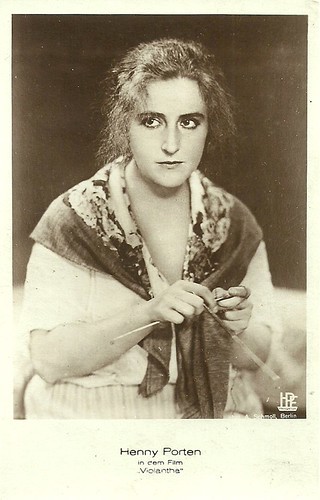
German postcard by Ross Verlag, no. 68/3. Photo: A. Schmoll, Berlin / Henny Porten-Film. Publicity still for Violantha (Carl Froehlich, 1927).
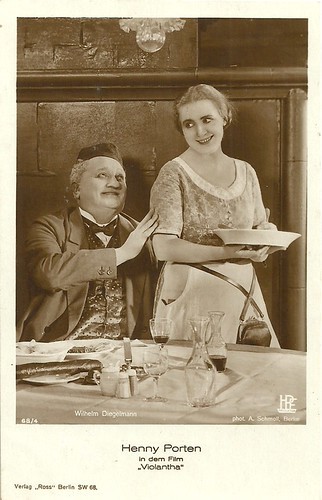
German postcard by Ross Verlag, no. 68/4. Photo: A. Schmoll, Berlin / Henny Porten-Film. Publicity still for Violantha (Carl Froehlich, 1927) with Henny Porten and Wilhelm Diegelmann.
A dark family secret in the Swiss Alps
Violantha (Carl Froehlich, 1927) was scripted by Walter Supper, Hans Wilhelm, and Ernst Zahn, and was adapted from the novel Der Schatten (1904) by Ernst Zahn.
Ms. Zureich (Elsa Wagner) is the owner of a hostel in the Swiss Val Tremola (Ticino Alps), which has a pretty bad reputation. To generate additional revenues, she presses her employees and even her own daughter to sexually provide themselves to the hosts. Only her niece Violantha ( Henny Porten ) can escape such impositions.
One day a company of soldiers set up their quarters nearby in preparation for a manoeuvre. Since soldiers are often sexually starved because of their long service, Violantha has the good sense to stay away from these people. Nevertheless, a lieutenant manages to seduce the young woman and drag her to her bed.
To his great misfortune, his immediate superior, the commander of the troop, is on a general inspection tour and notices the unauthorised absence of his officer. When he returns to his company at the camp, he is immediately arrested for unauthorised removal from the troops. Violantha, who does not know why suddenly her lieutenant has vanished, thinks her part of it and leaves her valley in the Ticino for the city, hoping to find work there. She finally receives it from the old innkeeper Hofer (Wilhelm Diegelmann).
Meanwhile, years pass by in the countryside. Alderman Alderich Renner (Wilhelm Dieterle) tries to woo Violantha, who since the unpleasant meeting with the soldier has become quite shy. Finally, she gives in to his urge to marry him. Shortly before the wedding, Violantha learns of her future from his dark family secret. He has a brother named Marianus (Alexander Sacha), the 'black sheep' of the family, who, one day, emigrated to America by night and fog, and since then nothing was heard from him again.
One day, when Marianus reappears in Alderich's hometown out of nowhere, Violantha, now the mother of two children, realises with horror that this man is her former soldierly seducer. Not that Marianus now asks for forgiveness for his sexual surprise act, no: he rather tries to make Violantha again compliant by threatening her, he will otherwise exchange words with his brother over her previous life.
Violantha, however, is not ready to be blackmailed by Marianus, and flees on her own into the mountains. Marianus follows her and wants to rape her this time. It comes to a fight in which the villain finds his death falling from a cliff into the depths. Freed from all the shadows of the past, the faithful wife returns to her husband Alderich.
The film's happy ending is different from the more tragic in the novel by Ernst Zahn. In Zahn's novel, Violantha knows the identity of her seducer from the very beginning, and she finally kills him intentionally in the mountains and then poisons herself.
Violantha was shot from August to October 1926 in the Efa studio in Berlin-Halensee (the interiors) and in Switzerland (the exteriors on the Gotthard massif, in Flüelen, Airolo, Andermatt, Hospental, Schöllenen and in the Val Treola). The not even four-year-old Inge Landgut made her film debut here as Porten's daughter. The sets were designed by Franz Schroedter, the costumes by Ali Hubert, while cinematography was by Axel Graatkjær and Gustave Preiss.
The six-act film passed German censorship on 9 March 1927, but had already premiered on 19 January 1927 in the Zurich Capitol cinema. In Germany Violantha was first shown at the Munich Phoebia-Kino on 25 November 1927. In 1942, the Ufa presented another film adaptation directed by Paul May. This sound version was released in German cinemas under the slightly changed title Violanta and it starred Annelies Reinhold.
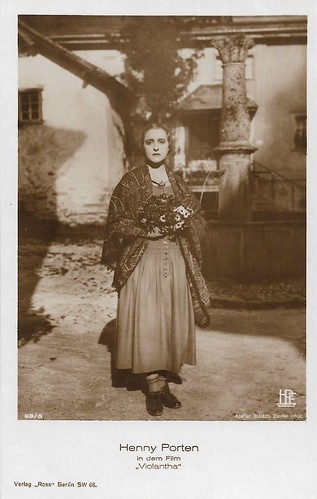
German postcard by Ross Verlag, no. 68/5. Photo: Atelier Balázs, Berlin / Henny Porten-Film. Publicity still for Violantha (Carl Froehlich, 1927) with Henny Porten
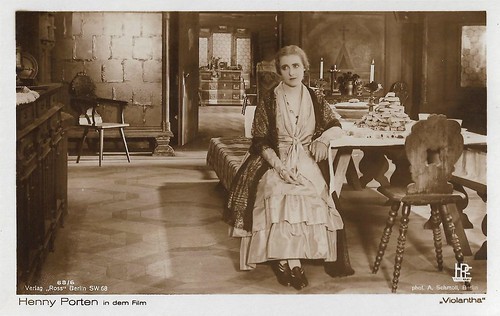
German postcard by Ross Verlag, no. 68/6. Photo: A. Schmoll, Berlin / Henny Porten-Film. Publicity still for Violantha (Carl Froehlich, 1927).
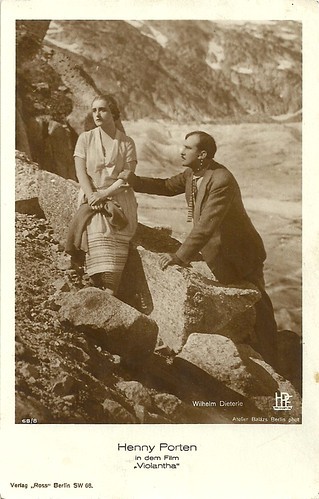
German postcard by Ross Verlag, no. 68/8. Photo: Atelier Balázs, Berlin / Henny Porten-Film. Publicity still for Violantha (Carl Froehlich, 1927) with Henny Porten and Wilhelm Dieterle .
Sources: Wikipedia (German) and IMDb.

German postcard by Ross Verlag, no. 68/1. Photo: Atelier Balázs, Berlin / Henny Porten-Film. Publicity still for Violantha (Carl Froehlich, 1927) with Henny Porten .

German postcard by Ross Verlag, no. 68/2. Photo: A. Schmoll, Berlin / Henny Porten-Film. Publicity still for Violantha (Carl Froehlich, 1927) with Henny Porten and Inge Landgut.

German postcard by Ross Verlag, no. 68/3. Photo: A. Schmoll, Berlin / Henny Porten-Film. Publicity still for Violantha (Carl Froehlich, 1927).

German postcard by Ross Verlag, no. 68/4. Photo: A. Schmoll, Berlin / Henny Porten-Film. Publicity still for Violantha (Carl Froehlich, 1927) with Henny Porten and Wilhelm Diegelmann.
A dark family secret in the Swiss Alps
Violantha (Carl Froehlich, 1927) was scripted by Walter Supper, Hans Wilhelm, and Ernst Zahn, and was adapted from the novel Der Schatten (1904) by Ernst Zahn.
Ms. Zureich (Elsa Wagner) is the owner of a hostel in the Swiss Val Tremola (Ticino Alps), which has a pretty bad reputation. To generate additional revenues, she presses her employees and even her own daughter to sexually provide themselves to the hosts. Only her niece Violantha ( Henny Porten ) can escape such impositions.
One day a company of soldiers set up their quarters nearby in preparation for a manoeuvre. Since soldiers are often sexually starved because of their long service, Violantha has the good sense to stay away from these people. Nevertheless, a lieutenant manages to seduce the young woman and drag her to her bed.
To his great misfortune, his immediate superior, the commander of the troop, is on a general inspection tour and notices the unauthorised absence of his officer. When he returns to his company at the camp, he is immediately arrested for unauthorised removal from the troops. Violantha, who does not know why suddenly her lieutenant has vanished, thinks her part of it and leaves her valley in the Ticino for the city, hoping to find work there. She finally receives it from the old innkeeper Hofer (Wilhelm Diegelmann).
Meanwhile, years pass by in the countryside. Alderman Alderich Renner (Wilhelm Dieterle) tries to woo Violantha, who since the unpleasant meeting with the soldier has become quite shy. Finally, she gives in to his urge to marry him. Shortly before the wedding, Violantha learns of her future from his dark family secret. He has a brother named Marianus (Alexander Sacha), the 'black sheep' of the family, who, one day, emigrated to America by night and fog, and since then nothing was heard from him again.
One day, when Marianus reappears in Alderich's hometown out of nowhere, Violantha, now the mother of two children, realises with horror that this man is her former soldierly seducer. Not that Marianus now asks for forgiveness for his sexual surprise act, no: he rather tries to make Violantha again compliant by threatening her, he will otherwise exchange words with his brother over her previous life.
Violantha, however, is not ready to be blackmailed by Marianus, and flees on her own into the mountains. Marianus follows her and wants to rape her this time. It comes to a fight in which the villain finds his death falling from a cliff into the depths. Freed from all the shadows of the past, the faithful wife returns to her husband Alderich.
The film's happy ending is different from the more tragic in the novel by Ernst Zahn. In Zahn's novel, Violantha knows the identity of her seducer from the very beginning, and she finally kills him intentionally in the mountains and then poisons herself.
Violantha was shot from August to October 1926 in the Efa studio in Berlin-Halensee (the interiors) and in Switzerland (the exteriors on the Gotthard massif, in Flüelen, Airolo, Andermatt, Hospental, Schöllenen and in the Val Treola). The not even four-year-old Inge Landgut made her film debut here as Porten's daughter. The sets were designed by Franz Schroedter, the costumes by Ali Hubert, while cinematography was by Axel Graatkjær and Gustave Preiss.
The six-act film passed German censorship on 9 March 1927, but had already premiered on 19 January 1927 in the Zurich Capitol cinema. In Germany Violantha was first shown at the Munich Phoebia-Kino on 25 November 1927. In 1942, the Ufa presented another film adaptation directed by Paul May. This sound version was released in German cinemas under the slightly changed title Violanta and it starred Annelies Reinhold.

German postcard by Ross Verlag, no. 68/5. Photo: Atelier Balázs, Berlin / Henny Porten-Film. Publicity still for Violantha (Carl Froehlich, 1927) with Henny Porten

German postcard by Ross Verlag, no. 68/6. Photo: A. Schmoll, Berlin / Henny Porten-Film. Publicity still for Violantha (Carl Froehlich, 1927).

German postcard by Ross Verlag, no. 68/8. Photo: Atelier Balázs, Berlin / Henny Porten-Film. Publicity still for Violantha (Carl Froehlich, 1927) with Henny Porten and Wilhelm Dieterle .
Sources: Wikipedia (German) and IMDb.
Published on April 22, 2019 22:00
Paul van Yperen's Blog
- Paul van Yperen's profile
- 13 followers
Paul van Yperen isn't a Goodreads Author
(yet),
but they
do have a blog,
so here are some recent posts imported from
their feed.



